Toshiba 30HF83 User Manual
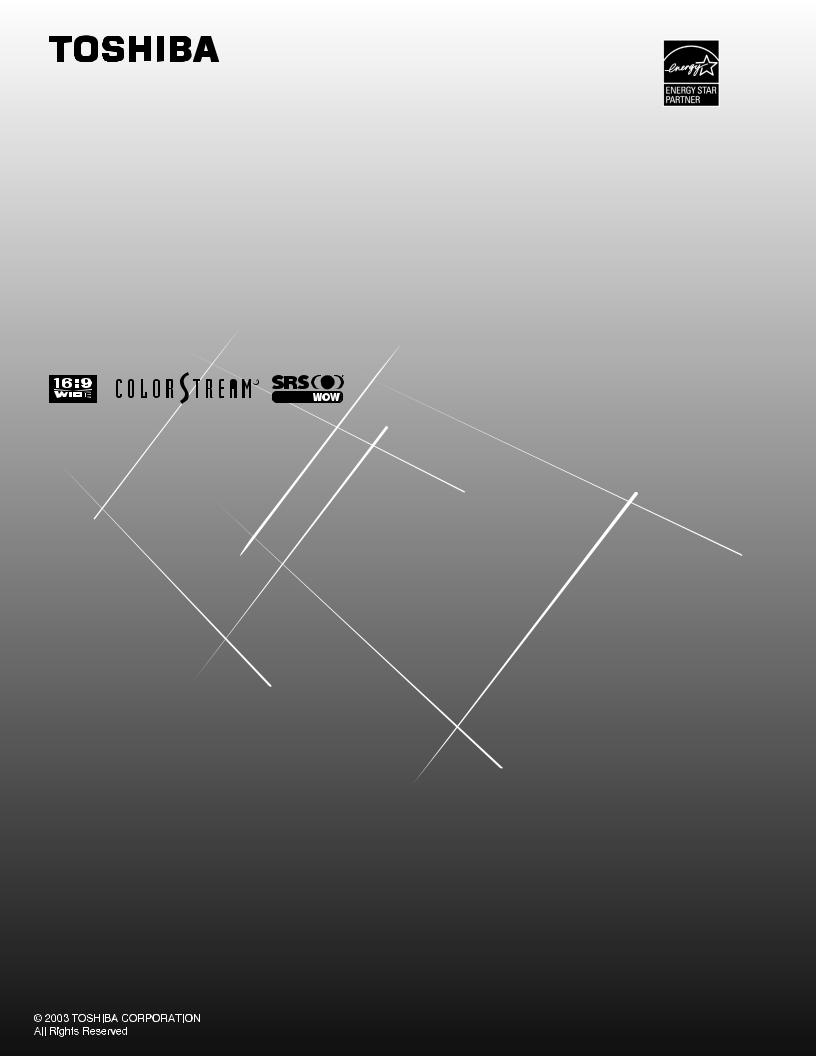
OWNER'S MANUAL
Color Television
Owner’s Record
|
|
|
|
|
|
NSU |
|
|
|
|
|
|
|
|
|
|
O |
ME |
|
|
|
||
|
|
|
|
C |
|
|
R |
P |
|||
|
|
A |
|
|
|
|
|
||||
|
|
C |
|
|
|
|
|
|
|
R |
|
|
|
I |
|
|
|
|
|
|
|
|
|
|
|
R |
|
|
|
|
|
|
|
|
D |
|
M |
E |
|
|
|
|
|
|
|
|
O |
A |
|
|
|
|
|
|
|
|
U |
||
|
|
|
|
|
|
|
|
|
T |
||
A |
|
|
|
|
|
|
|
|
|
|
C |
|
|
|
|
|
|
|
|
|
|
S |
|
B |
|
|
|
|
|
|
|
|
|
|
|
I |
|
|
|
|
|
|
|
|
|
|
, |
|
|
|
|
|
|
|
|
|
|
L |
|
H |
|
|
|
|
|
|
|
|
|
|
|
S |
|
|
|
|
|
|
|
|
|
|
. |
|
|
|
|
|
|
|
|
|
|
L |
|
O |
|
|
|
|
|
|
|
|
|
|
|
|
|
|
|
|
|
|
|
|
|
. |
|
|
|
|
|
|
|
|
|
|
|
|
C |
T |
|
|
|
|
|
|
|
|
|
. |
|
|
|
|
|
|
|
|
|
|
|
||
I |
|
|
|
|
|
|
|
|
|
||
|
|
1 |
|
|
|
|
|
|
|
|
9 |
|
|
4 |
|
|
|
|
|
|
A |
||
|
|
|
0 |
1 |
|
|
|
. |
|
||
|
|
|
|
0 |
|
|
o |
|
|
||
|
|
|
|
|
|
|
FILEN |
|
|
|
|
The model number and serial number are on the back of your TV. Record these numbers in the spaces below. Refer to these numbers whenever you communicate with your Toshiba dealer about this TV.
30HF83 |
Model number: |
30HF83 |
Serial number: |
|
|
|
||
|
|
Introduction |
|
|
|
|
|
Connecting |
yourTV |
|
|
|
|
Usingthe |
RemoteControl |
|
|
|
|
Settingup |
yourTV |
|
|
|
|
UsingtheTV’s |
Features |
|
|
|
|
Appendix |
|
|
|
|
|
Index |
|
|
|
23566176A
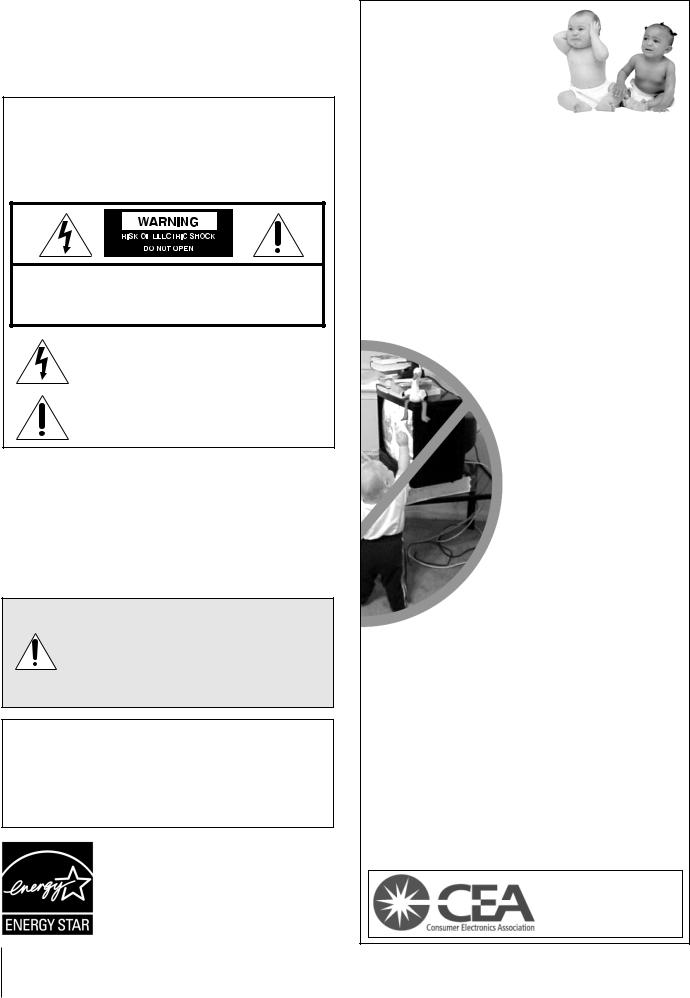
Dear Customer,
Thank you for purchasing this Toshiba TV. This manual will help you use the many exciting features of your new TV.
Before operating the TV, please read this manual completely, and keep it nearby for future reference.
Safety Precautions
WARNING
TO REDUCE THE RISK OF FIRE OR ELECTRIC SHOCK, DO NOT EXPOSE THIS APPLIANCE TO RAIN OR MOISTURE.
WARNING: TO REDUCE THE RISK OF ELECTRIC SHOCK, DO NOT REMOVE COVER (OR BACK). NO USER-SERVICEABLE PARTS INSIDE. REFER
SERVICING TO QUALIFIED SERVICE PERSONNEL.
The lightning symbol in the triangle tells you that the voltage inside this product may be strong enough to cause an electric shock. DO NOT TRY TO SERVICE THIS PRODUCT YOURSELF.
The exclamation mark in the triangle tells you that important operating and maintenance instructions follow this symbol.
NOTE TO CATV INSTALLERS IN THE USA
This is a reminder to call the CATV system installer’s attention to Article 820-40 of the NEC, which provides guidelines for proper grounding and, in particular, specifies that the cable ground shall be connected to the grounding system of the building, as close to the point of cable entry as practical. For additional antenna grounding information, see items 25
and 26 on page 4.
NOTICE OF POSSIBLE TV STAND INSTABILITY
DANGER: RISK OF SERIOUS PERSONAL INJURY OR DEATH! Use this TV with the TOSHIBA TV stand recommended in the “Specifications” section only.
Use with other stands may result in instability, causing possible injury or death.
NOTICE OF POSSIBLE ADVERSE EFFECTS
ON TV PICTURE TUBE
If a fixed (non-moving) pattern remains on the TV screen for long periods of time, the image can become permanently engrained in the picture tube. This type of damage is NOT COVERED BY YOUR WARRANTY. See item 33 on page 4.
ENERGY STAR® qualified TV. Products that earn the ENERGY STAR prevent green house gas emissions by meeting strict energy efficiency guidelines set by the U.S. Environmental Protection Agency and the U.S. Department of Energy. ENERGY STAR and the ENERGY STAR
mark are registered U.S. marks.
0104
Child Safety
It Makes A Difference
Where Your TV Stands
Congratulations on your purchase! As you enjoy your new TV, keep these safety tips in mind:
The Issue
If you are like most consumers, you have a TV in your home. Many homes, in fact, have more than one TV.
The home theater entertainment experience is a growing trend, and larger TVs are popular purchases; however, they are not always supported on the proper TV stands.
Sometimes TVs are improperly secured or inappropriately situated on dressers, bookcases, shelves, desks, audio speakers, chests, or carts. As a result, TVs may fall over, causing unnecessary injury.
Cares!
consumer electronics industry committed to making home
entertainment enjoyable and safe.The Consumer Electronics Association formed the Home
Entertainment Support Safety Committee, comprised of TV and consumer electronics furniture manufacturers, to advocate children’s safety and educate
consumers and their families about television safety.
Into Safety
does NOT fit all! Use appropriate enough to support the weight of your
TV (and other electronic components).
Use appropriate angle braces, straps, and anchors to secure your furniture to the wall (but never screw anything directly into the TV).
Carefully read and understand the other enclosed instructions for proper use of this product.
Do not allow children to climb on or play with furniture and TVs.
Avoid placing any item on top of your TV (such as a VCR, remote control, or toy) that a curious child may reach for.
Remember that children can become excited while watching a program and can potentially push or pull a TV over.
Share our safety message about this hidden hazard of the home with your family and friends. Thank you!
2500 Wilson Blvd. Arlington, VA 22201 U.S.A.
Tel. 703-907-7600 Fax 703-907-7690 www.CE.org
CEA is the Sponsor, Producer and Manager of the International CES®
2
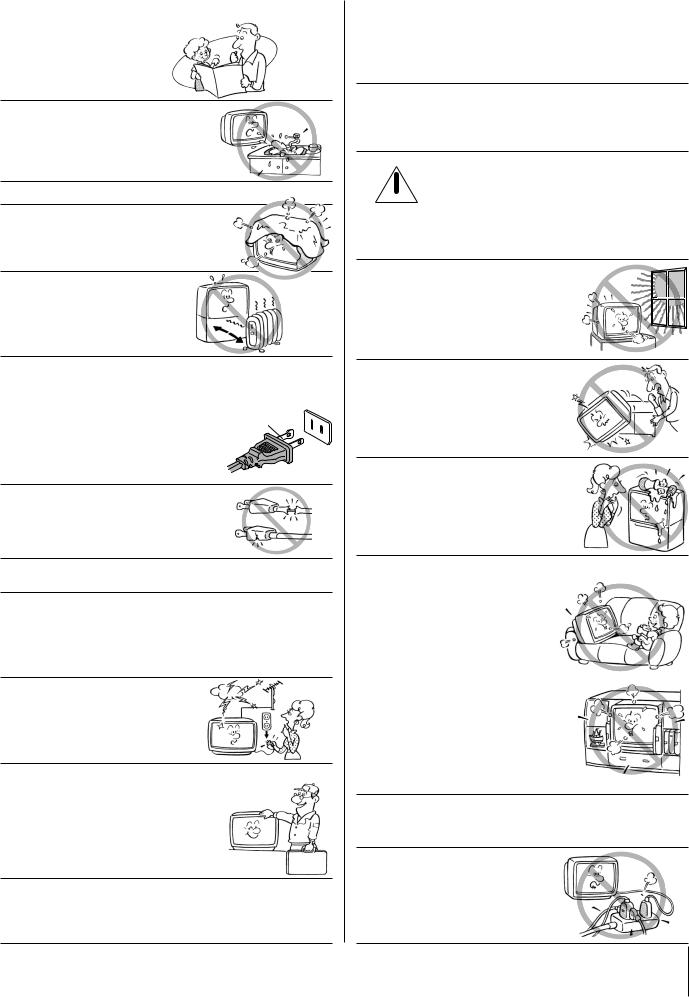
Important Safety Instructions
1)Read these instructions.
2)Keep these instructions.
3)Heed all warnings.
4)Follow all instructions.
5)Do not use this apparatus near water.
6)Clean only with a dry cloth.
7)Do not block any ventilation openings. Install in accordance with the manufacturer’s instructions.
8)Do not install near any heat sources such as radiators, heat registers, stoves, or other apparatus (including amplifiers) that produce heat.
9)Do not defeat the safety purpose of the polarized or grounding type plug. A polarized plug has two blades
with one wider than the other. A grounding type plug has two blades and a third grounding
prong. The wide blade or the third prong are provided for your safety. If the provided plug does not fit into your outlet, consult an electrician
for replacement of the obsolete outlet.
10)Protect the power cord from being walked on or pinched, particularly at plugs, convenience receptacles, and the point where it exits the apparatus.
11)Only use attachments/accessories specified by the manufacturer.
12)Use only with the cart, stand, tripod, bracket, or table specified by the manufacturer, or sold with the apparatus. When a cart is used, use caution when moving the cart/apparatus combination to avoid injury from tip-over.
13) Unplug this apparatus during lightning storms or when unused for long periods
of time.
14)Refer all servicing to qualified service personnel.
Servicing is required when the apparatus damaged in any way, such as power cord or plug is damaged, liquid has been spilled or objects have fallen into the apparatus, the apparatus has been
exposed to rain or moisture, does not operate normally, or has been dropped.
15)CAUTION: To reduce the risk of electric shock, do not use the polarized plug with an extension cord, receptacle, or other outlet unless the blades can be inserted completely to prevent blade exposure.
Installation, Care, and Service
Installation
Follow these recommendations and precautions and heed all warnings when installing your TV:
16)Never modify this equipment. Changes or modifications may void: a) the warranty, and b) the user’s authority to operate this equipment under the rules of the Federal Communications Commission.
17)DANGER: RISK OF SERIOUS PERSONAL INJURY, DEATH, OR EQUIPMENT
 DAMAGE! Never place the TV on an unstable cart, stand, or table. The TV may fall, causing serious personal injury, death, or serious damage to the TV.
DAMAGE! Never place the TV on an unstable cart, stand, or table. The TV may fall, causing serious personal injury, death, or serious damage to the TV.
18) Never place or store the TV in direct sunlight; hot, humid areas; areas subject to excessive dust or vibration; or locations with temperatures at or below 41°F (5°C).
19)Always place the TV on the floor
or a sturdy, level, stable surface that can support the weight of the unit.
20)Never place items such as vases, aquariums, or candles on top of the TV
21)Never block or cover the slots or openings in the TV cabinet back, bottom, and sides. Never place the TV:
•on a bed, sofa, rug, or similar surface;
•too close to drapes, curtains, or walls; or
•in a confined space such as a bookcase, built-in cabinet, or any other place with poor ventilation.
The slots and openings are provided to protect the TV from overheating and to help maintain reliable operation of the TV.
22)Never allow anything to rest on or roll over the power cord, and never place the TV where the power cord is subject to wear or abuse.
23)Never overload wall outlets and extension cords.
0303 3
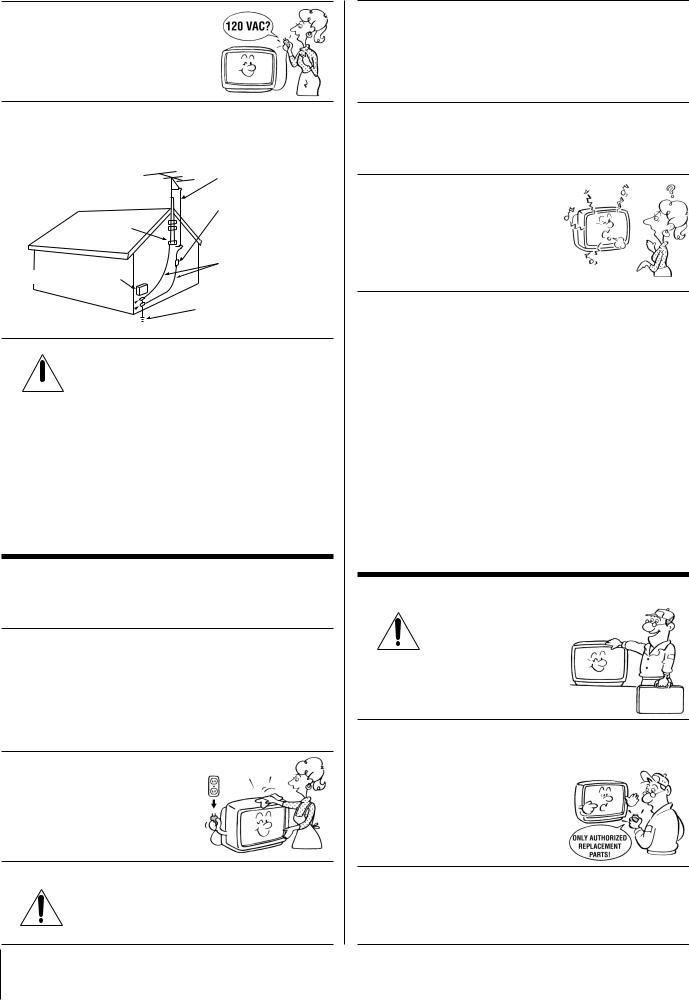
24)Always operate this equipment from a 120 VAC, 60 Hz power source only.
25)Always make sure the antenna system is properly grounded to provide adequate protection against voltage surges and built-up static charges (see Section 810 of the National Electric Code).
Ground clamp
Electric service equipment
Ground clamps 
Antenna lead-in wire
Antenna discharge unit (NEC Section 810-20)
Grounding conductors (NEC Section 810-21)
Power service grounding
electrode system (NEC Art 250 Part H)
26)DANGER: RISK OF SERIOUS PERSONAL INJURY OR DEATH!
 • Use extreme care to make sure you are never in a position where your body (or any item you are in contact with, such as a ladder or screwdriver) can accidentally touch overhead power lines. Never locate the antenna near overhead power lines or other electrical circuits.
• Use extreme care to make sure you are never in a position where your body (or any item you are in contact with, such as a ladder or screwdriver) can accidentally touch overhead power lines. Never locate the antenna near overhead power lines or other electrical circuits.
• Never attempt to install any of the following during lightning activity:
a) an antenna system; or b) cables, wires, or any home theater component connected to an antenna or phone system.
Care
For better performance and safer operation of your TOSHIBA TV, follow these recommendations and precautions:
27)Always sit approximately 10–25 feet away from the TV and as directly in front of it as possible. The picture can appear dull if you sit too far to the left or right of the TV, or if sunlight or room lights reflect on the screen. Turn the TV off to check for reflections on the screen, and then remove the source of reflections while viewing the TV.
28)Always unplug the TV before cleaning. Never use liquid or aerosol cleaners.
29)WARNING: RISK OF ELECTRIC SHOCK!
Never spill liquids or push objects of any kind
into the TV cabinet slots.
30)[This item applies to projection TVs only.] If the air temperature rises suddenly (for example, when the TV is first delivered), condensation may form on the lenses. This can make the picture appear distorted or the color appear faded. If this happens, turn off the TV for 6 to 7 hours to allow the condensation to evaporate.
31)For added protection of your TV from lightning and power surges, always unplug the power cord and disconnect the antenna from the TV if you leave the TV unattended or unused for long periods of time.
32)During normal use, the TV may make occasional snapping or popping sounds. This is normal, especially when the unit is being turned on or off. If these sounds become frequent or continuous, unplug the power cord
and contact a Toshiba Authorized Service Center.
33)Possible Adverse Effects on TV Picture Tube: If a fixed (non-moving) pattern remains on the TV screen for long periods of time, the image can become permanently engrained in the picture tube and cause subtle but permanent ghost images. This type of damage is NOT COVERED BY YOUR WARRANTY. Never leave your TV on for long periods of time while it is displaying the following formats or images:
•Fixed Images, such as PIP/POP windows, stock tickers, video game patterns, TV station logos, and websites.
•Special Formats that do not use the entire screen. For example, viewing letterbox style (16:9) media on a normal (4:3) display (gray bars at top and bottom of screen); or viewing normal style (4:3) media on a widescreen (16:9) display (gray bars on left and right sides of screen).
Service
34)WARNING: RISK OF ELECTRIC
SHOCK! Never attempt to service the TV yourself. Opening and
removing the covers may expose you to dangerous voltage or other hazards. Refer all servicing to a Toshiba Authorized Service Center.
QUALIFIED
SERVICE
TECHNICIAN
35)If you have the TV serviced:
•Ask the service technician to use only replacement parts specified by the manufacturer.
•Upon completion of service, ask the service technician to perform routine safety checks to determine that the TV is in safe operating condition.
36)When the TV reaches the end of its useful life, ask a qualified service technician to properly dispose of the TV. Improper disposal may result in a picture tube implosion and possible personal injury.
40303

Important Safety Information ............................. |
2-4 |
Introduction ................................................................ |
6 |
Welcome to Toshiba ......................................................... |
6 |
Exploring your new TV ................................................... |
6 |
Note regarding Quick Connect Guide ........................ |
6 |
Connecting your TV .................................................. |
7 |
Connecting a VCR .......................................................... |
7 |
Connecting a cable box .................................................... |
8 |
Connecting a cable box and VCR .................................... |
8 |
Connecting a DVD player or satellite receiver and |
|
a VCR .............................................................................. |
9 |
Connecting a DVD player with component video |
|
and a VCR ..................................................................... |
10 |
Connecting a DTV receiver/set-top box with component |
|
video and a VCR ........................................................... |
11 |
Connecting two VCRs ................................................... |
12 |
Connecting a camcorder ................................................ |
12 |
Connecting a device to the DVI/HDCP input .............. |
13 |
Connecting an audio system .......................................... |
14 |
Connecting an A/V receiver ........................................... |
14 |
Using the remote control ...................................... |
15 |
Preparing the remote control for use .............................. |
15 |
Installing the remote control batteries ............................ |
15 |
Programming the remote control ................................... |
16 |
Remote control codes (cont.) ................................... |
16–17 |
Using the remote control to operate your other devices .. 18 |
|
Learning about the remote control ................................. |
19 |
Setting up your TV .................................................. |
20 |
Learning about the menu system ................................... |
20 |
Changing the on-screen display language ....................... |
21 |
Selecting the antenna input ............................................ |
21 |
Programming channels into the channel memory .......... |
22 |
Programming channels automatically ...................... |
22 |
Adding and erasing channels manually .................... |
22 |
Using the Quick Connect Guide ................................... |
23 |
Changing channels ........................................................ |
24 |
Changing channels using SpeedSurf ........................ |
24 |
Adjusting the tilt correction feature ................................ |
24 |
Using the TV’s features.......................................... |
25 |
Adjusting the channel settings ........................................ |
25 |
Switching between two channels using Channel |
|
Return .................................................................... |
25 |
Switching between two channels using |
|
SurfLock™ ............................................................. |
25 |
Programming your favorite channels ....................... |
25 |
Labeling channels ................................................... |
27 |
Viewing the wide-screen picture formats ........................ |
28 |
Selecting the picture size ......................................... |
28 |
Scrolling the Theater Wide picture |
|
(Theater Wide 2 and 3 only) .................................. |
30 |
Using the auto aspect feature .................................. |
31 |
Selecting the cinema mode ...................................... |
31 |
Using the POP double-window feature .......................... |
32 |
Switching the main and POP pictures ..................... |
33 |
Freezing the POP picture ........................................ |
33 |
Adjusting the size of the double-window ................. |
33 |
POP double-window aspect ratio ............................ |
34 |
Using the programmed channel search function ............. |
34 |
Using the favorite channel search function .............. |
35 |
About the auto favorite feature ................................ |
35 |
Using the LOCKS menu ............................................... |
36 |
Entering the PIN code ............................................ |
36 |
If you cannot remember your PIN code .................. |
36 |
Using the V-CHIP menu ............................................... |
37 |
ENABLE BLOCKING .......................................... |
37 |
TV RATING (Independent rating system for |
|
broadcasters) ........................................................... |
37 |
MPAA RATING (Independent rating system for |
|
movies) ................................................................... |
38 |
BLOCKING OPTION .......................................... |
38 |
Unlocking programs temporarily ............................ |
39 |
Locking channels ........................................................... |
39 |
Locking video inputs ..................................................... |
40 |
Using the game timer ..................................................... |
41 |
Using the front panel lock feature .................................. |
41 |
Changing the PIN code ................................................. |
41 |
Adjusting the picture ..................................................... |
42 |
Selecting the picture mode ...................................... |
42 |
Adjusting the picture quality ................................... |
42 |
Saving your new preferences ................................... |
43 |
Using the flesh tone feature ..................................... |
43 |
Using the CableClear™ DNR feature .................... |
43 |
Selecting the color temperature ............................... |
44 |
Selecting the display format (for 480p signals only) |
44 |
Resetting your picture adjustments ......................... |
44 |
Selecting the video input source ..................................... |
45 |
Labeling the video input sources .................................... |
45 |
Using the closed caption feature ..................................... |
46 |
Setting the ON timer ..................................................... |
47 |
Setting the sleep timer .................................................... |
47 |
Setting the clock ............................................................ |
48 |
Selecting the background of the menu display ............... |
48 |
Adjusting the sound ....................................................... |
49 |
Muting the sound ................................................... |
49 |
Selecting stereo/SAP broadcasts .............................. |
49 |
Using the WOW™ surround sound feature ........... |
50 |
Adjusting the sound quality .................................... |
50 |
Resetting your audio adjustments ........................... |
51 |
Using the CYCLONE® sub-woofer system ............. |
51 |
Turning off the built-in speakers ............................. |
52 |
Selecting the Audio OUT sound ............................. |
52 |
Using the StableSound® feature .............................. |
53 |
Displaying on-screen information .................................. |
53 |
Viewing the demo mode ................................................ |
54 |
Understanding the auto power off feature ...................... |
54 |
Understanding the last mode memory feature ................ |
54 |
Appendix ................................................................... |
55 |
Specifications ................................................................. |
55 |
Troubleshooting ............................................................. |
56 |
Limited United States Warranty ..................................... |
57 |
Limited Canada Warranty .............................................. |
58 |
Index .......................................................................... |
59 |
5
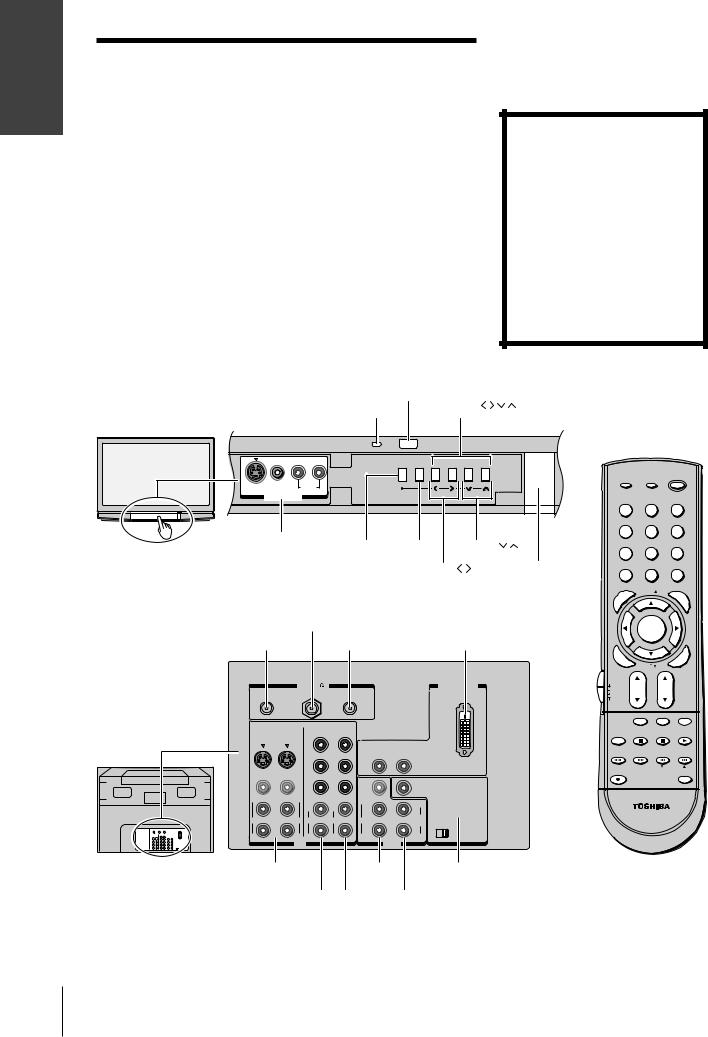
Introduction
Introduction
Welcome to Toshiba
Congratulations! You have purchased one of the finest color TVs on the market. The goal of this manual is to guide you through setting up and operating your Toshiba TV as quickly as possible.
Instructions in this manual are based on using the remote control. You can also use the controls on the TV if they have the same name as those on the remote control.
Please read all the safety and operating instructions carefully, and keep the manual for future reference.
Exploring your new TV
You can operate your TV using the buttons on the front panel or the remote control. The back panel and front panel (behind the door) provide all the terminal connections you will need to connect other equipment to your TV. See “Connecting your TV” on page 7.
Remote sensor
Note regarding Quick Connect Guide
The Quick Connect Guide automatically appears on-screen the first time the TV is turned on. This feature provides on-screen instructions to guide you through initial setup of your TV.
To stop the Quick Connect Guide, either press EXIT or turn off the TV.
See page 23 for details.
|
|
Power indicator |
MENU |
|
|
|
|
|
|
|
|
|
|||
Front |
|
|
|
|
|
|
|
|
|
|
|
|
|
|
|
|
|
|
|
|
|
|
|
|
|
Remote control |
|||||
|
L/MONO |
R |
|
MENU TV/VIDEO VOLUME |
CHANNEL |
|
|
|
|
|
|
|
|
|
|
|
|
|
|
|
|
POWER |
|
|
|
|
|
|
|
|
|
|
|
|
|
|
|
|
|
|
|
TV/VIDEO |
RECALL |
POWER |
|
||
|
|
|
|
|
|
|
|
|
|
|
|
|
|||
S-VIDEO VIDEO |
AUDIO |
|
|
|
|
|
|
|
|
|
|
INFO |
|
|
|
VIDEO-3 IN |
|
|
|
|
|
|
|
|
|
|
|
|
|
||
|
|
|
|
|
|
|
|
|
|
|
|
|
|
||
|
|
|
|
|
|
|
|
|
|
|
1 |
2 |
3 |
|
|
Video-3 |
|
|
|
|
|
|
|
|
|
4 |
5 |
6 |
|
|
|
|
MENU |
TV/VIDEO |
Channel |
|
|
|
|
|
|
|
|
|
|||
Video/audio inputs |
|
|
|
|
7 |
8 |
9 |
|
|
||||||
|
|
Volume |
POWER |
|
|
|
|
|
|
||||||
(behind the door) |
|
|
|
|
|
|
+10 |
|
CHRTN |
|
|||||
|
|
|
|
|
|
|
|
|
|
100 |
0 |
ENT |
|
|
|
|
|
|
|
|
|
|
|
|
|
N |
|
G |
|
|
|
|
|
|
|
|
|
|
|
|
|
E |
U |
FAV |
UI |
||
|
|
|
|
|
|
|
|
|
P |
M |
|
PIC |
D |
||
|
|
|
|
|
|
|
|
O |
FAVORITE |
|
|
E |
|||
|
|
|
|
|
|
|
T |
|
|
|
|
SI |
|
|
|
|
|
|
|
|
|
|
|
|
|
|
|
|
ZE |
||
ANT OUT
|
|
|
|
|
|
|
|
|
MENU |
|
|
|
|
ANT-1 IN |
|
ANT-2 IN |
|
|
DVI/HDCP IN |
|
DVDMENU |
|
|
|
|||
|
|
|
|
|
|
|
|
|
|||||
|
|
|
|
|
|
|
|
NENTER |
|
|
EXIT |
|
R |
|
|
|
|
|
|
|
|
T |
|
|
|
|
|
|
|
|
|
|
|
|
|
E |
|
|
|
EA |
|
|
|
|
|
|
|
|
|
E |
FAV |
|
|
|
|
|
|
|
|
|
|
|
|
R |
|
|
L |
|
|
|
|
|
|
|
|
|
|
|
|
C |
|
|
|
|
ANT( 75 ) |
|
|
|
|
DVI/HDCP IN |
TV |
CH |
VOL |
|
|
|
|
ANT-1 |
|
OUT |
ANT-2 |
|
|
|
|
CBL/SAT |
|
|
|
||
|
|
|
|
|
VCR |
|
|
|
|
|
|||
|
|
|
|
|
|
|
|
DVD |
|
|
|
|
|
|
|
|
|
|
|
|
|
POP DIRECT CH MUTE |
SLEEP |
|
|||
VIDEO 1 |
VIDEO 2 |
COLOR |
COLOR |
|
|
|
|
|
|
|
|
|
|
S-VIDEO |
S-VIDEO |
STREAM HD-1 |
STREAM HD-2 |
|
|
|
|
TV/VCR |
PAUSE |
STOP |
PLAY |
|
|
Y |
Y |
AUDIO |
|
|
|
|
|
|
|
|
|
||
|
|
|
|
|
|
FREEZE |
SOURCE |
SPLIT |
|
||||
Back |
|
|
|
|
|
|
|
|
|||||
|
|
|
R |
L |
|
|
REW |
FF |
SKIP/SEARCH |
|
|||
|
|
PB |
PB |
|
|
|
|
CH SCAN |
SWAP |
POP CH |
|
|
|
|
|
|
|
|
|
|
|
|
|
||||
VIDEO |
VIDEO |
|
|
|
|
|
|
REC |
|
|
LIGHT |
|
|
|
|
VIDEO |
|
|
|
|
|
|
|
|
|
||
|
|
PR |
PR |
|
|
AUDIO CENTER |
|
|
|
|
|
|
|
|
|
|
|
|
|
|
|
|
|
|
|||
L/ |
L/ |
|
|
L/ |
|
|
CHANNEL IN |
|
|
|
|
|
|
|
|
|
|
|
|
|
|
|
|
|
|||
MONO |
MONO |
|
|
MONO |
|
L |
|
|
|
|
|
|
|
|
|
|
|
|
|
|
|
|
|
|
|
||
|
|
L |
L |
|
|
|
|
|
|
|
|
|
|
|
|
|
|
|
|
|
|
|
|
|
|
||
AUDIO |
AUDIO |
AUDIO |
AUDIO |
AUDIO |
|
VAR |
|
|
CT-90159 |
|
|
|
|
|
AUDIO |
ON OFF |
|
|
|
|
|
|
|||||
|
|
|
|
|
|
|
|
|
|
|
|
||
|
|
|
|
|
|
|
|
|
|
|
|
|
|
R |
R |
R |
R |
R |
|
R |
|
|
|
|
|
|
|
|
IN |
|
|
OUT |
|
|
|
|
|
|
|
|
|
VIDEO 1/2 |
|
|
Video/ |
|
Audio Center Channel IN |
|
|
|
|
|
|
||
|
|
|
Audio OUT |
|
Variable Audio OUT |
|
|
|
|
|
|
||
ColorStream |
ColorStream |
|
|
|
|
|
|
|
|||||
|
|
|
|
|
|
|
|
|
|||||
|
HD-1 |
HD-2 |
|
|
|
|
|
|
|
|
|
||
6
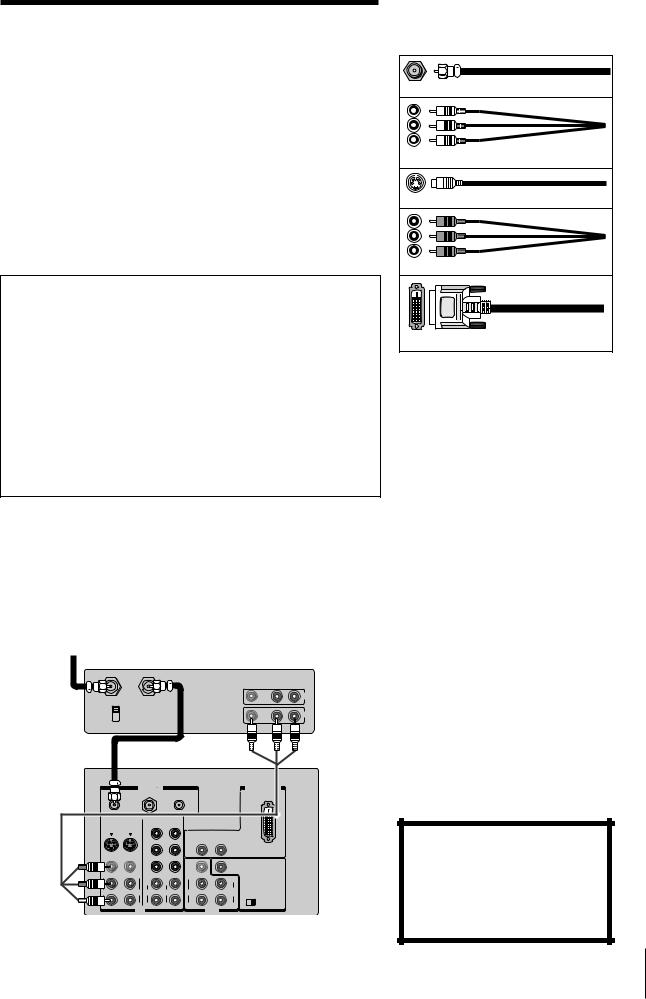
Connecting your TV
Note: Cables are not supplied with your TV.
●Coaxial cable is the cable that comes in from your antenna, cable TV service, or cable converter box. Coaxial cable uses “F” connectors.
●Standard A/V (audio/video) cables usually come in sets of three, and are typically color-coded according to use: yellow for video, red for stereo right audio, and white for stereo left (or mono) audio.
On your TV’s back panel, the standard A/V inputs are color-coded in the same manner as the cables.
●S-Video cable is for use with video equipment with S-Video output.
●Component video cables come in sets of three (color-coded red, green and blue), and are for use with video equipment with component video outputs. (ColorStream® is Toshiba’s brand
of component video.)
●DVI-D digital single-link cable is for use with video equipment with DVI-D output (see page 13).
NOTE REGARDING PICTURE QUALITY
When connecting video equipment to your Toshiba TV:
●For GOOD picture quality: Use a standard yellow video cable.
●For BETTER picture quality: If your equipment has an S-video input, use an S-video cable instead of a standard yellow video cable. (You still must connect the standard red and white audio cables for full system connection, but do not connect the standard yellow video cable at the same time, or the picture performance will be unacceptable.)
●For BEST picture quality: If your equipment has component video (or DVI) inputs, use either component video cables (or a DVI cable) instead of a standard video or S-video cable. (You still must connect the standard red and white audio cables for full system connection, but do not connect the standard yellow video cable or an S-Video cable at the same time.)
Coaxial (antenna) cable
Standard A/V cables (red/white/yellow)
S-video cable
Component video cables (red, green, blue)
DVI-D digital single-link cable
CAUTION:
Do not plug in any power cords until you have finished connecting all equipment.
Connecting a VCR
This connection allows you to watch local channels and video programs, play or record on the VCR while watching TV, and record from one channel while watching another channel.
You will need:
•two coaxial cables
•one set of standard A/V cables
From Cable Box or Antenna
Stereo VCR
VIDEO |
AUDIO |
|
|
L |
R |
IN from ANT OUT to TV |
IN |
|
|
||
CH 3 |
OUT |
|
CH 4 |
||
|
TV |
|
|
|
|
|
|
|
|
ANT( 75 |
) |
|
|
|
DVI/HDCP IN |
|
ANT-1 |
|
OUT |
|
ANT-2 |
|
|
|
VIDEO 1 |
VIDEO 2 |
COLOR |
|
COLOR |
|
|
|
|
|
STREAM HD-1 |
STREAM HD-2 |
|
|
|
|
S-VIDEO |
S-VIDEO |
Y |
|
Y |
|
AUDIO |
|
|
|
|
|
|
|||
|
|
|
|
|
|
|
|
|
|
|
|
|
R |
L |
|
|
|
PB |
|
PB |
|
|
|
VIDEO |
VIDEO |
|
|
|
VIDEO |
|
|
|
|
PR |
|
PR |
|
AUDIO CENTER |
|
|
|
|
|
|
|||
L/ |
L/ |
|
|
|
L/ |
|
CHANNEL IN |
MONO |
MONO |
|
|
|
MONO |
L |
|
|
|
L |
|
L |
|
|
|
|
|
|
|
|
|
||
AUDIO |
AUDIO |
AUDIO |
|
AUDIO |
AUDIO |
VAR |
|
|
AUDIO |
ON OFF |
|||||
|
|
|
|
|
|
||
|
|
|
|
|
|
|
|
R |
R |
R |
|
R |
R |
R |
|
|
IN |
|
|
|
|
OUT |
|
Note:
If you have a mono VCR, connect L/Mono to VCR Audio OUT using only one audio cable.
If you have a VCR with S-video, use an
S-video cable (plus audio cables) instead of the standard video cable for better picture performance.
Do not connect a standard video cable and an S-video cable to VIDEO 1 (or VIDEO 2) at the same time, or the picture performance will be unacceptable.
The unauthorized recording, use, distribution, or revision of television programs, videotapes, DVDs, and other materials is prohibited under the Copyright Laws of the United States and other countries, and may subject you to civil and criminal liability.
Introduction |
|
|
|
|
|
Connecting |
yourTV |
|
|
|
|
Usingthe |
RemoteControl |
|
|
|
|
Settingup |
yourTV |
|
|
|
|
UsingtheTV’s |
Features |
|
|
|
|
Appendix |
|
|
|
|
|
Index |
|
|
|
7
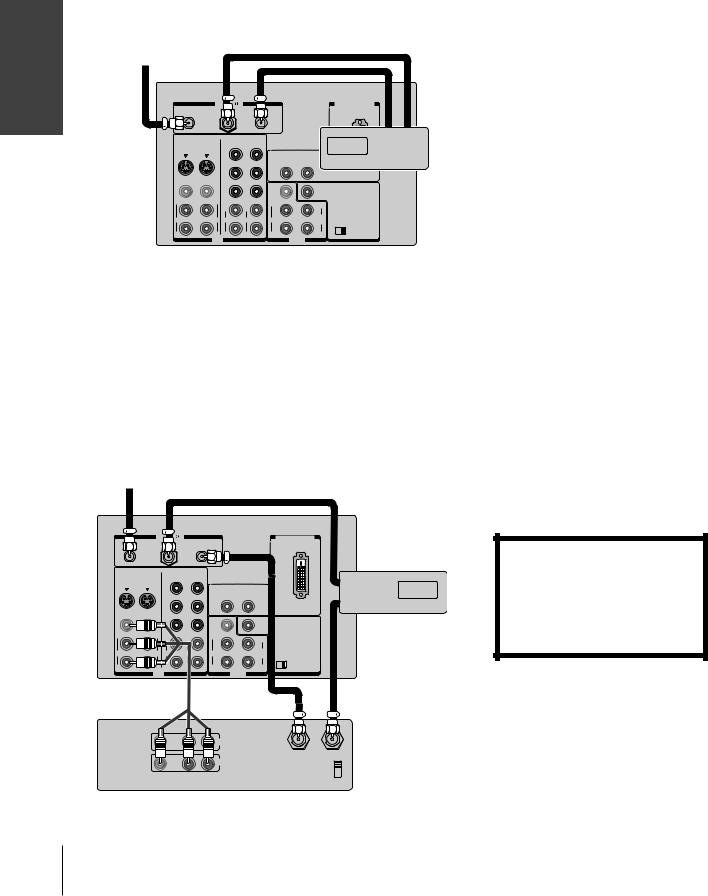
Connecting your TV
Connecting a cable box
This connection allows you to watch basic and premium cable channels.
To watch basic cable and use the TV’s features, select ANT-1. To view premium channels, select ANT-2, tune the TV to channel 3 or 4 (whichever channel is vacant in your area), and use the cable box to change channels.
You will need:
• three coaxial cables
From Cable
TV
|
ANT( 75 ) |
DVI/HDCP IN |
ANT-1 |
OUT |
ANT-2 |
VIDEO 1 VIDEO 2
S-VIDEO S-VIDEO
VIDEO |
VIDEO |
L/ |
L/ |
MONO |
MONO |
AUDIO |
AUDIO |
R |
R |
|
IN |
COLOR |
COLOR |
|
|
|
OUT IN |
|
|
|
|
||
STREAM HD-1 |
STREAM HD-2 |
|
|
|
|
Y |
Y |
|
AUDIO |
|
|
|
|
|
|
Cable box |
|
|
|
R |
L |
|
|
PB |
PB |
|
|
|
|
PR |
PR |
VIDEO |
|
|
AUDIO CENTER |
|
|
|
|||
|
|
L/ |
|
|
CHANNEL IN |
|
|
|
|
|
|
|
|
MONO |
|
L |
|
L |
L |
|
|
|
|
|
|
|
|
||
AUDIO |
AUDIO |
AUDIO |
|
VAR |
|
|
AUDIO |
ON OFF |
|||
|
|
|
|
||
|
|
|
|
|
|
R |
R |
R |
|
R |
|
OUT
Note:
When you use a cable box with your TV, the remote control will not operate some features, such as programming your favorite channels, labeling channels, and locking channels.
Connecting a cable box and VCR
This connection allows you to watch and record basic and premium cable channels, watch videotapes, and record one channel while watching another channel. To watch basic cable and use the TV’s features, select ANT-1.
To view premium channels or record with the VCR, select ANT-2, tune the TV to channel 3 or 4 (whichever channel is vacant in your area), and use the cable box to change channels.
You will need:
•four coaxial cables
•one set of standard A/V cables
From Cable
TV
|
ANT( 75 ) |
|
|
|
DVI/HDCP IN |
|
|
ANT-1 |
|
OUT |
ANT-2 |
|
|
|
|
VIDEO 1 |
VIDEO 2 |
COLOR |
COLOR |
|
|
|
|
|
|
STREAM HD-1 |
STREAM HD-2 |
|
IN |
|
|
S-VIDEO |
S-VIDEO |
Y |
Y |
|
AUDIO |
|
|
|
|
|
|
|
|||
|
|
|
|
|
|
|
|
|
|
|
|
R |
L |
OUT |
|
|
|
PB |
PB |
|
|
Cable box |
|
|
|
|
|
|
|
|
|
VIDEO |
VIDEO |
|
|
VIDEO |
|
|
|
|
|
PR |
PR |
|
AUDIO CENTER |
|
|
|
|
|
|
|
|||
L/ |
L/ |
|
|
L/ |
|
CHANNEL IN |
|
|
|
|
|
|
|||
MONO |
MONO |
|
|
MONO |
L |
|
|
|
|
|
|
|
|
||
|
|
L |
L |
|
|
|
|
|
|
|
|
|
|
||
AUDIO |
AUDIO |
AUDIO |
AUDIO |
AUDIO |
VAR |
|
|
AUDIO |
ON OFF |
|
|||||
|
|
|
|
|
|
||
|
|
|
|
|
|
|
|
R |
R |
R |
R |
R |
R |
|
|
|
IN |
|
|
|
OUT |
|
|
|
|
|
L |
R |
|
|
|
|
|
|
|
IN |
|
|
|
|
|
|
|
|
|
OUT to TV IN from ANT |
|
|
|
|
|
OUT |
|
CH 3 |
|
|
|
|
|
|
|
|
|
|
VIDEO |
L |
R |
|
CH 4 |
|
|
|
AUDIO |
|
|
|
|||
|
|
|
|
|
|
||
Stereo VCR
Note:
If you have a mono VCR, connect L/Mono to VCR Audio OUT using only one audio cable.
If you have a VCR with S-video, use an
S-video cable (plus audio cables) instead of a regular video cable. Do not connect a standard video cable and an S-video cable to VIDEO 1 (or VIDEO 2) at the same time or the picture perfomance will not be acceptable.
When you use a converter box with your TV, the remote control will not operate some features, such as programming your favorite channels, labeling channels, and locking channels.
The unauthorized recording, use, distribution, or revision of television programs, videotapes, DVDs, and other materials is prohibited under the Copyright Laws of the United States and other countries, and may subject you to civil and criminal liability.
8
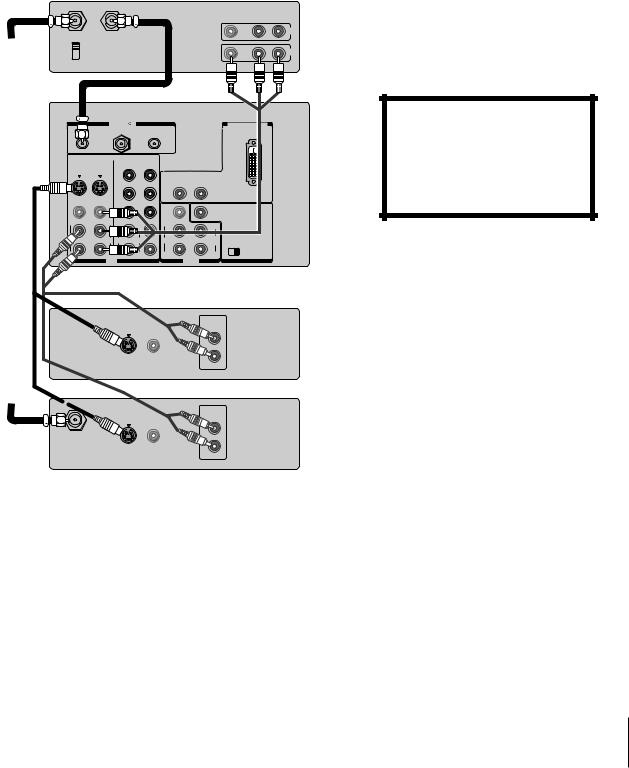
Connecting a DVD player or satellite receiver (without component video) and a VCR
This connection allows you to watch DVD/satellite, VCR, and TV programs, and record one TV channel while watching another channel.
You will need:
•two coaxial cables (three if satellite receiver is used)
•one set of standard A/V cables
•one pair of audio cables
•one S-video cable (between the TV and DVD player/satellite receiver)
Stereo VCR
|
|
|
|
|
|
VIDEO |
AUDIO |
|
|
|
|
|
|
|
|
|
L R |
|
IN from ANT |
OUT to TV |
|
|
|
|
IN |
|
From |
|
|
|
|
|
|||
CH 3 |
|
|
|
|
|
|
OUT |
|
Antenna |
CH 4 |
|
|
|
|
|
|
|
|
|
|
|
|
|
|
|
|
|
TV |
|
|
|
|
|
|
|
|
|
ANT( 75 ) |
|
|
|
DVI/HDCP IN |
||
|
ANT-1 |
|
OUT |
ANT-2 |
|
|
|
|
|
VIDEO 1 |
VIDEO 2 |
COLOR |
COLOR |
|
|
|
|
|
|
|
STREAM HD-1 |
STREAM HD-2 |
|
|
|
|
|
S-VIDEO |
S-VIDEO |
Y |
Y |
|
AUDIO |
|
|
|
|
|
|
|
|
|||
|
|
|
|
|
|
|
|
|
|
|
|
|
|
R |
L |
|
|
|
|
|
PB |
PB |
|
|
|
|
|
VIDEO |
VIDEO |
|
|
VIDEO |
|
|
|
|
|
|
PR |
PR |
|
AUDIO CENTER |
||
|
|
|
|
|
||||
|
L/ |
L/ |
|
|
L/ |
|
CHANNEL IN |
|
|
MONO |
MONO |
|
|
|
|
|
|
|
|
|
MONO |
L |
|
|
||
|
|
|
|
|
|
|
||
|
|
|
L |
L |
|
|
|
|
|
|
|
|
|
|
|
||
|
AUDIO |
AUDIO |
AUDIO |
AUDIO |
AUDIO |
VAR |
|
|
|
AUDIO |
ON OFF |
|
|||||
|
|
|
|
|
|
|
||
|
|
|
|
|
|
|
|
|
|
R |
R |
R |
R |
R |
R |
|
|
|
|
IN |
|
|
|
OUT |
|
|
|
|
|
|
|
|
|
|
DVD Player |
|
|
|
|
|
|
AUDIO |
|
|
|
|
|
|
|
|
OUT |
|
|
|
|
|
|
|
|
L |
|
|
|
|
|
|
|
|
R |
|
|
From |
|
|
S-VIDEO VIDEO |
|
|
|
||
|
|
OUT |
OUT |
|
|
|
|
|
Satellite |
|
|
|
|
|
Satellite Receiver |
||
Dish |
|
|
|
|
|
|||
|
|
|
|
|
|
|
|
|
|
|
|
|
|
|
AUDIO |
|
|
|
|
|
|
|
|
OUT |
|
|
|
|
|
|
|
|
L |
|
|
|
IN from ANT |
|
|
|
|
|
|
|
R
S-VIDEO VIDEO
OUT OUT
Note:
For the highest possible picture quality from a DVD player/satellite receiver, without component video (or DVI/HDCP), use an
S-video cable. If your DVD player or satellite receiver has component video, see page 10.
If your DVD player or satellite receiver has DVI/HDCP, see page 13.
Do not connect an S-video cable and a standard video cable to VIDEO 1 (or VIDEO 2) or the picture performance will be unacceptable.
Do not connect the DVD player/satellite receiver and VCR to the same set of A/V inputs on the TV. (See the illustration, which shows the DVD player/satellite receiver connected to VIDEO 1 on the TV, and the VCR connected to VIDEO 2 on the TV.)
The unauthorized recording, use, distribution, or revision of television programs, videotapes, DVDs, and other materials is prohibited under the Copyright Laws of the United States and other countries, and may subject you to civil and criminal liability.
Introduction |
|
|
|
|
|
Connecting |
yourTV |
|
|
|
|
Usingthe |
RemoteControl |
|
|
|
|
Settingup |
yourTV |
|
|
|
|
UsingtheTV’s |
Features |
|
|
|
|
Appendix |
|
|
|
|
|
Index |
|
|
|
9
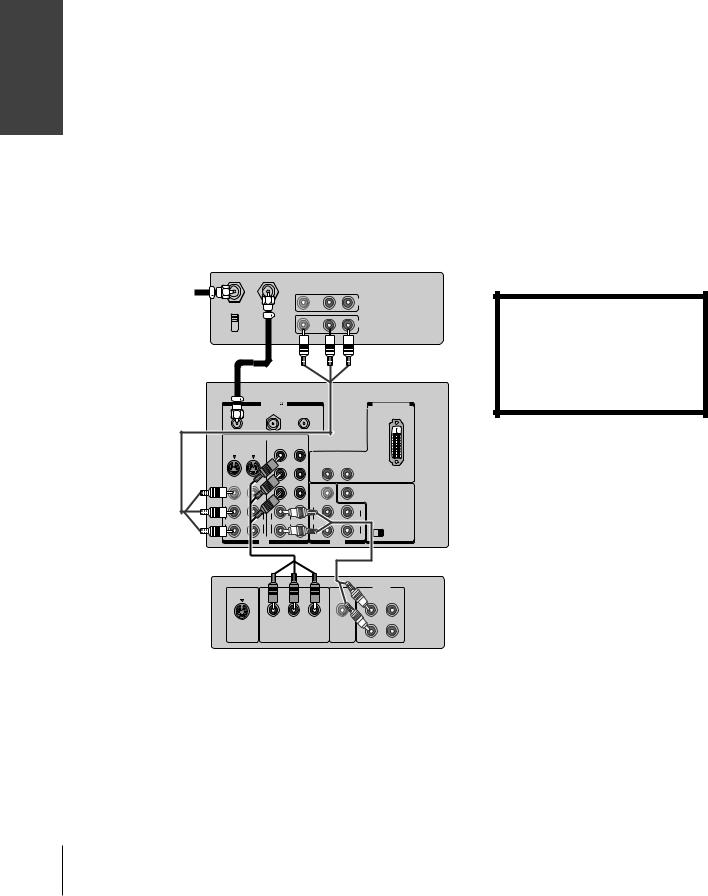
Connecting your TV
Connecting a DVD player with component video and a VCR
This connection allows you to watch DVD, VCR, and TV programs, and record TV programs.
Your TV has ColorStream® (component video) inputs. Connecting your TV to a DVD player with component video inputs (such as a Toshiba DVD player with ColorStream®) can greatly enhance picture quality and realism.
–To record one TV program while watching another TV program, tune the VCR to the channel to record, and tune the TV to the channel to watch.
–To record a TV program while watching a DVD, tune the VCR to the channel to record, and select ColorStream HD-1 on the TV (see “Selecting the antenna input” on page 21).
You will need:
•two coaxial cables
•one set of standard A/V cables
•one pair of audio cables
•one set of component video cables
Stereo VCR
|
IN from ANT OUT to TV |
|
From Antenna |
VIDEO |
AUDIO |
|
L R |
|
|
|
|
|
|
IN |
|
CH 3 |
|
|
|
|
|
OUT |
|
CH 4 |
|
|
|
|
|
|
|
|
|
|
|
|
|
|
|
TV |
|
|
|
|
|
|
|
|
ANT( 75 |
) |
|
|
|
DVI/HDCP IN |
|
ANT-1 |
|
OUT |
|
ANT-2 |
|
|
|
VIDEO 1 |
VIDEO 2 |
COLOR |
|
COLOR |
|
|
|
|
|
STREAM HD-1 |
STREAM HD-2 |
|
|
|
|
S-VIDEO |
S-VIDEO |
Y |
|
Y |
|
AUDIO |
|
|
|
|
|
|
|||
|
|
|
|
|
|
|
|
|
|
|
|
|
R |
L |
|
|
|
PB |
|
PB |
|
|
|
VIDEO |
VIDEO |
|
|
|
VIDEO |
|
|
|
|
PR |
|
PR |
|
AUDIO CENTER |
|
|
|
|
|
|
|||
L/ |
L/ |
|
|
|
L/ |
|
CHANNEL IN |
|
|
|
|
|
|||
MONO |
MONO |
|
|
|
MONO |
L |
|
|
|
|
|
|
|
||
|
|
L |
|
L |
|
|
|
|
|
|
|
|
|
||
AUDIO |
AUDIO |
AUDIO |
|
AUDIO |
AUDIO |
VAR |
|
|
AUDIO |
ON OFF |
|||||
|
|
|
|
|
|
||
|
|
|
|
|
|
|
|
R |
R |
R |
|
R |
R |
R |
|
|
IN |
|
|
|
|
OUT |
|
Note:
For the highest possible picture quality, use component video cables (or a DVI-D singlelink cable) between the TV and DVD player. You can connect component video cables to either set of ColorStream jacks on the TV (HD-1 or HD-2).
The ColorStream HD-1 and HD-2 jacks can be used with Progressive (480p, 720p) and Interlaced (480i,1080i) scan systems. A 1080i signal will provide the best picture performance.
If your DVD player does not have component video (or DVI/HDCP,) use the S-video connections plus the standard audio connections instead. Do not connect both
S-Video and standard video cables to VIDEO 1 (or VIDEO2) at the same time or the picture performance will be unacceptable. See page 9.
For DVI/HDCP connection, see page 13.
The unauthorized recording, use, distribution, or revision of television programs, videotapes, DVDs, and other materials is prohibited under the Copyright Laws of the United States and other countries, and may subject you to civil and criminal liability.
AUDIO
OUT
L L
Y PB PR
S-VIDEO |
COMPONENT VIDEO VIDEO |
R |
R |
|
OUT |
|
|
DVD Player with component video
10
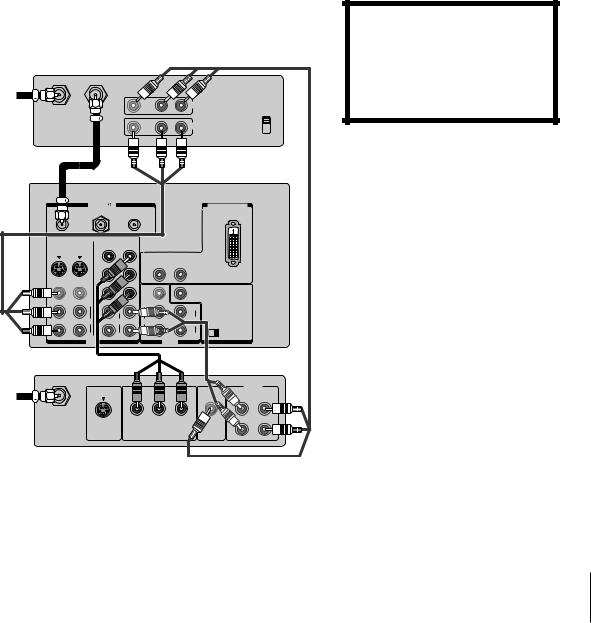
Connecting a DTV receiver/set-top box with component video and a VCR
This connection allows you to watch DTV (digital TV), VCR, and TV programs, and record DTV and TV programs.
Your TV has ColorStream (component video) inputs. Connecting your TV to a DTV receiver with component video inputs can greatly enhance picture quality and realism.
–To record and watch a DTV program, select LINE IN on the VCR, and select ColorStream HD-2 (or VIDEO 1 for a nonColorStream connection) on the TV (see “Selecting the antenna input” on page 21).
–To record a TV program while watching a DTV program, tune the VCR to the channel to record, and select ColorStream HD-2 on the TV.
–To record and watch the same TV program, tune the VCR to the channel to record, and select VIDEO 1 on the TV.
–To record one TV program while watching another TV program, tune the VCR to the channel to record, and tune the TV to the channel to watch.
You will need:
•three coaxial cables
•two sets of standard A/V cables
•one pair of audio cables
•one set of component video cables
|
Stereo VCR |
From |
IN from ANT OUT to TV |
Antenna |
VIDEO AUDIO |
L R |
|
|
|
|
|
|
IN |
|
|
|
|
|
|
|
|
OUT |
|
CH 3 |
|
|
|
|
|
|
|
CH 4 |
|
|
|
|
|
|
|
|
|
|
TV |
|
|
|
|
|
|
|
|
|
ANT( 75 |
) |
|
|
|
DVI/HDCP IN |
|
|
ANT-1 |
|
OUT |
|
ANT-2 |
|
|
|
|
VIDEO 1 |
VIDEO 2 |
COLOR |
|
COLOR |
|
|
|
|
|
|
STREAM HD-1 |
STREAM HD-2 |
|
|
|
|
|
S-VIDEO |
S-VIDEO |
Y |
|
Y |
|
AUDIO |
|
|
|
|
|
|
|
|
|||
|
|
|
|
|
|
|
|
|
|
|
|
|
|
R |
L |
|
|
|
|
PB |
|
PB |
|
|
|
|
VIDEO |
VIDEO |
|
|
|
VIDEO |
|
|
|
|
|
PR |
|
PR |
|
AUDIO CENTER |
||
|
|
|
|
|
||||
L/ |
L/ |
|
|
|
L/ |
|
CHANNEL IN |
|
MONO |
MONO |
|
|
|
|
|
|
|
|
|
|
MONO |
L |
|
|
||
|
|
|
|
|
|
|
||
|
|
L |
|
L |
|
|
|
|
|
|
|
|
|
|
|
||
AUDIO |
AUDIO |
AUDIO |
|
AUDIO |
AUDIO |
VAR |
|
|
|
AUDIO |
ON OFF |
|
|||||
|
|
|
|
|
|
|
||
|
|
|
|
|
|
|
|
|
R |
R |
R |
|
R |
R |
R |
|
|
|
IN |
|
|
|
|
OUT |
|
|
From |
|
|
|
|
|
|
|
OUT |
|
|
|
|
|
|
|
AUDIO |
|
DTV Antenna |
|
|
|
Y |
PB |
PR |
L |
L |
|
|
|
|
|
|
|||
Satelite IN |
|
|
|
|
|
|
|
|
S-VIDEO |
COMPONENT VIDEO VIDEO |
R |
R |
|
OUT |
|
|
DTV Receiver with component video
Note:
For the highest possible picture quality, use component video cables (or a DVI-D singlelink cable) between TV and DTV receiver. You can connect the component video cables to either set of ColorStream jacks on the TV (HD-1 or HD-2).
The ColorStream HD-1 and HD-2 jacks can be used with Progressive (480p, 720p) and Interlaced (480i,1080i) scan systems. A 1080i signal will provide the best picture performance.
If your DTV receiver does not have component video (or DVI-HDCP video), use the S-video and standard audio connections instead. Do not connect both an S-video and a standard video cable to VIDEO1 (or VIDEO2) at the same time or the picture performance will be unacceptable.
For DVI/HDCP connection, see page 13.
To monitor recording, set the TV to VIDEO 1.
The unauthorized recording, use, distribution, or revision of television programs, videotapes, DVDs, and other materials is prohibited under the Copyright Laws of the United States and other countries, and may subject you to civil and criminal liability.
Introduction |
|
|
|
|
|
Connecting |
yourTV |
|
|
|
|
Usingthe |
RemoteControl |
|
|
|
|
Settingup |
yourTV |
|
|
|
|
UsingtheTV’s |
Features |
|
|
|
|
Appendix |
|
|
|
|
|
Index |
|
|
|
11
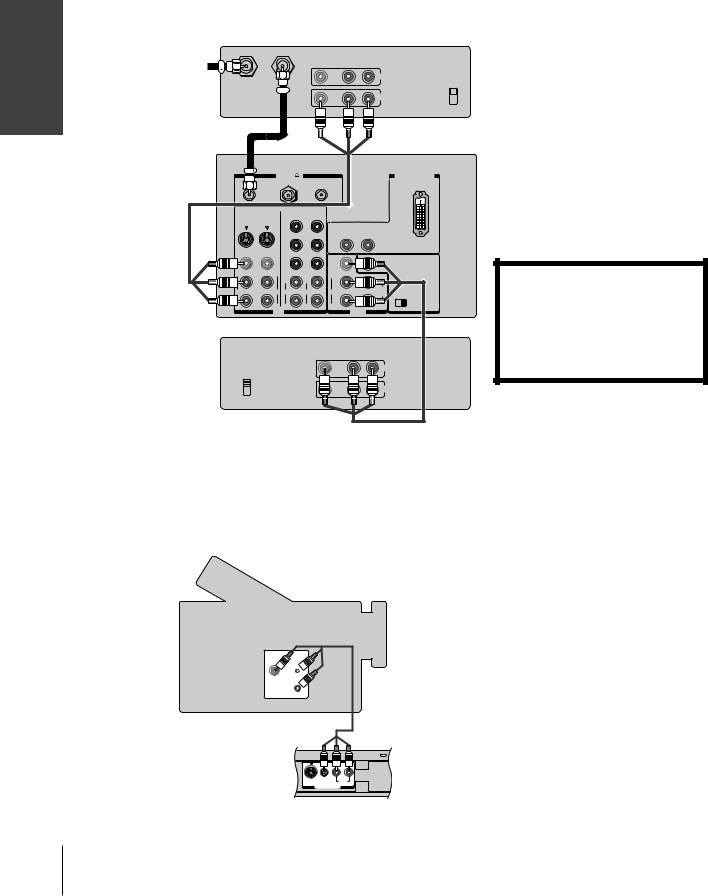
Connecting your TV
Connecting two VCRs
This connection allows you to record (dub/edit) from one VCR to another VCR while watching a videotape. You can also record from one TV channel while watching another TV channel.
You will need:
•two coaxial cables
•two sets of standard A/V cables
VCR1
|
IN from ANT OUT to TV |
|
From Antenna |
VIDEO |
AUDIO |
|
L R |
|
|
|
IN |
CH 3 
OUT |
CH 4 |
|
TV
|
ANT( 75 ) |
DVI/HDCP IN |
ANT-1 |
OUT |
ANT-2 |
VIDEO 1 |
VIDEO 2 |
COLOR |
COLOR |
|
|
|
|
|
|
STREAM HD-1 |
STREAM HD-2 |
|
|
|
|
S-VIDEO |
S-VIDEO |
Y |
Y |
|
AUDIO |
|
|
|
|
|
|
||||
|
|
|
|
|
|
||
|
|
|
|
R |
L |
|
|
|
|
PB |
PB |
|
|
|
|
VIDEO |
VIDEO |
|
|
VIDEO |
|
|
|
|
|
PR |
PR |
|
AUDIO CENTER |
||
|
|
|
|
||||
L/ |
L/ |
|
|
L/ |
|
CHANNEL IN |
|
MONO |
MONO |
|
|
|
|
||
|
|
MONO |
L |
|
|||
|
|
L |
L |
|
|
||
|
|
|
|
|
|||
AUDIO |
AUDIO |
AUDIO |
AUDIO |
AUDIO |
VAR |
|
|
AUDIO |
ON OFF |
||||||
|
|
|
|
|
|||
|
|
|
|
|
|
||
R |
R |
R |
R |
R |
R |
|
|
|
IN |
|
|
|
OUT |
|
|
VCR2 |
|
|
|
|
|
|
|
|
|
|
VIDEO |
AUDIO |
|
||
|
|
|
|
L |
R |
|
|
|
|
|
|
|
IN |
|
|
CH 3 |
|
|
|
|
OUT |
|
|
CH 4 |
|
|
|
|
|
||
|
|
|
|
|
|
||
|
|
|
|
* |
** |
|
|
Connecting a camcorder
This connection allows you to watch video materials recorded on a camcorder.
You will need:
• one set of standard A/V cables
Camcorder
VIDEO AUDIO
OUT
L 
R 
L/MONO R
S-VIDEO VIDEO |
AUDIO |
VIDEO-3 IN
Video-3 (front panel)
Note:
If VCR1 has S-video, you can use an S-video cable instead of the standard video cable for better picture performance. Do not connect both a standard video cable and an S-video cable to VIDEO 1 (or VIDEO 2) at the same time, or the picture performance will be unacceptable.
Do not connect the same VCR to the output and input jacks on the TV at the same time.
To dub or edit, VCR 2 must select Line IN, and the TV must select VIDEO 1 (see “Selecting the antenna input” on page 21).
The unauthorized recording, use, distribution, or revision of television programs, videotapes, DVDs, and other materials is prohibited under the Copyright Laws of the United States and other countries, and may subject you to civil and criminal liability.
*The Video OUT jack does not output the POP picture.
**The Audio OUT jacks can output the sound of either the Main or POP picture (see “Selecting the Audio OUT sound” on page 52).
Note:
If your camcorder has S-video, you can use an S-video cable instead of the standard video cable for better picture performance. Do not connect both a standard video cable and an S-video cable at the same time, or the picture performance will be unacceptable.
12
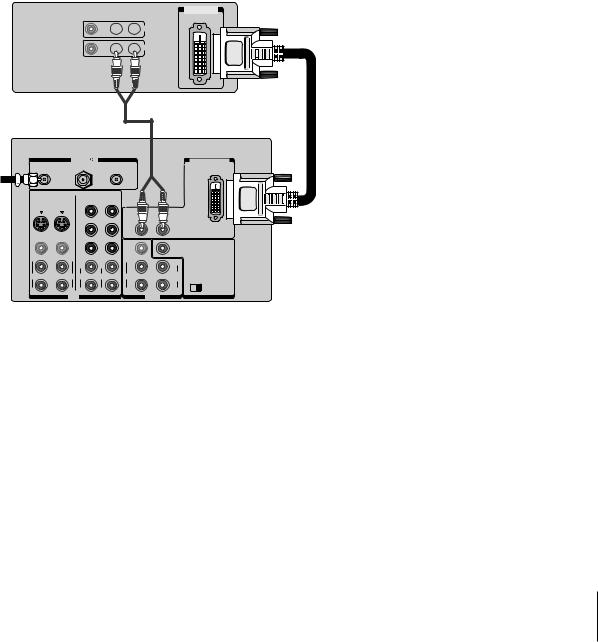
Connecting a device to the DVI/HDCP input
The DVI/HDCP1 input on your TV is designed to accept HDCP program material in digital form from EIA/CEA-861–compliant2 consumer electronic devices, such as a set-top box or DVD player equipped with a DVI-D digital single-link output connection.3
The DVI/HDCP input is designed for best performance with 1080i high-definition video signals. The DVI/HDCP input also will accept and display 480p, 480i and 720p picture signals.
Note: This TV is not intended for connection to and should not be used with a PC (personal computer).
You will need:
•one coaxial cable
•one pair of standard audio cables
•one DVI-D digital single-link cable
Note: For proper operation, the DVI-D cable length should not exceed 3m (9.8 ft). The recommended length is 2m (6.6 ft).
DVI/HDCP device
(for example, set-top box or DVD player)
VIDEO |
AUDIO |
DVI/HDCP |
|
|
L |
R |
OUT |

 IN
IN

 OUT
OUT
|
TV |
|
|
|
|
|
|
|
|
ANT( 75 ) |
|
|
|
DVI/HDCP IN |
|
|
ANT-1 |
|
OUT |
ANT-2 |
|
|
|
From |
|
|
|
|
|
|
|
antenna |
VIDEO 1 |
VIDEO 2 |
COLOR |
COLOR |
|
|
|
or cable |
|
|
STREAM HD-1 |
STREAM HD-2 |
|
|
|
S-VIDEO |
S-VIDEO |
Y |
Y |
|
AUDIO |
|
|
|
|
|
|
|
|
|
|
|
|
|
|
|
R |
L |
|
|
|
|
PB |
PB |
|
|
|
|
VIDEO |
VIDEO |
|
|
VIDEO |
|
|
|
|
|
PR |
PR |
|
AUDIO CENTER |
|
|
|
|
|
|
|||
|
L/ |
L/ |
|
|
L/ |
|
CHANNEL IN |
|
|
|
|
|
|||
|
MONO |
MONO |
|
|
MONO |
L |
|
|
|
|
|
|
|
||
|
|
|
L |
L |
|
|
|
|
|
|
|
|
|
||
|
AUDIO |
AUDIO |
AUDIO |
AUDIO |
AUDIO |
VAR |
|
|
AUDIO |
ON OFF |
|||||
|
|
|
|
|
|
||
|
|
|
|
|
|
|
|
|
R |
R |
R |
R |
R |
R |
|
|
|
IN |
|
|
|
OUT |
|
Note:
1DVI/HDCP = Digital Visual Interface/ High-bandwidth Digital Content Protection.
2EIA/CEA-861 compliance covers the transmission of uncompressed digital video with high-bandwidth digital content protection, which is being standardized for reception of high-definition video signals.
3Consult your consumer electronics dealer for availability.
Caution:
To ensure that the DVI/HDCP device is reset properly, it is recommended that you follow these procedures:
•When turning on your electronic components, turn on the TV first, and then the DVI/HDCP device.
•When turning off your electronic components, turn off the DVI/HDCP device first, and then the TV.
Introduction |
|
|
|
|
|
Connecting |
yourTV |
|
|
|
|
Usingthe |
RemoteControl |
|
|
|
|
Settingup |
yourTV |
|
|
|
|
UsingtheTV’s |
Features |
|
|
|
|
Appendix |
|
|
|
|
|
Index |
|
|
|
13
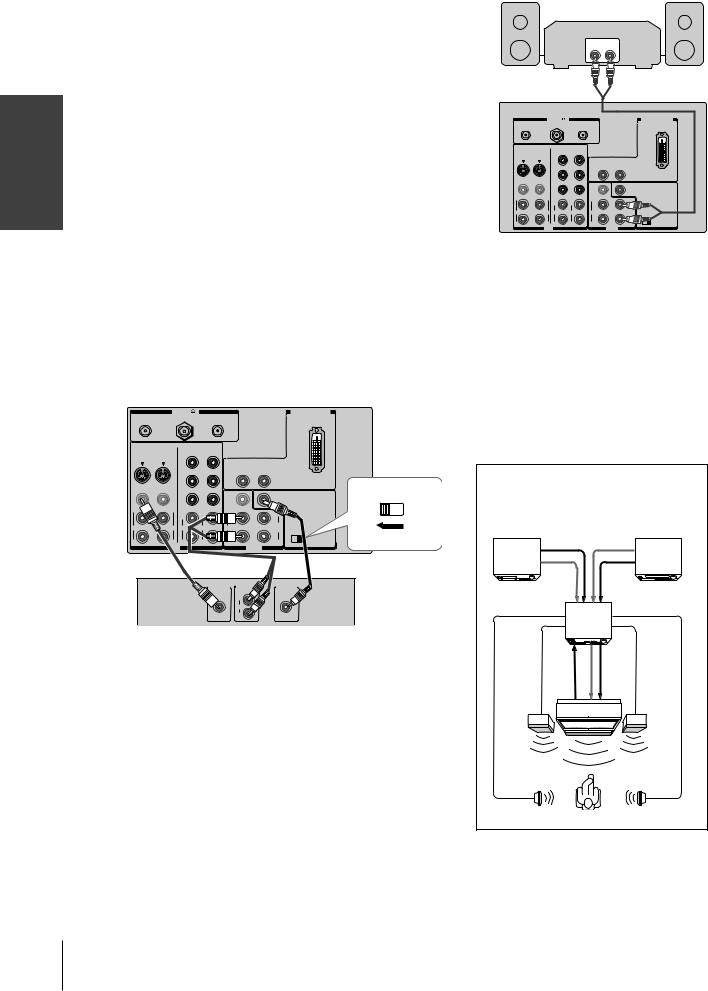
Connecting your TV
Connecting an audio system
This connection allows you to use external speakers with an external audio amplifier to adjust the sound level.
To control the audio, turn on the TV and the stereo amplifier, and turn off the built-in speakers (see “Turning off the built-in speakers” on page 52).
You will need:
• one pair of audio cables
Note:
To hear sound when using an external audio amplifier, the volume of both the TV and the amplifier must be set to a moderate listening level.
Connecting an A/V receiver
This connection allows you to use an audio/video (A/V) receiver to enhance your TV’s sound.
If you have a sound system with Dolby Pro Logic surround sound, you can add to the realism of the sound by using the TV’s internal speakers as center channel speakers.
You will need:
•one set of standard A/V cables
•one single standard audio cable for the audio center channel
|
ANT( 75 ) |
|
|
|
DVI/HDCP IN |
|
|
ANT-1 |
|
OUT |
ANT-2 |
|
|
|
|
VIDEO 1 |
VIDEO 2 |
COLOR |
COLOR |
|
|
|
|
|
|
STREAM HD-1 |
STREAM HD-2 |
|
|
|
|
S-VIDEO |
S-VIDEO |
Y |
Y |
|
AUDIO |
|
|
|
|
|
|
|
|||
|
|
|
|
|
|
|
|
|
|
|
|
R |
L |
|
|
|
|
PB |
PB |
|
|
|
|
VIDEO |
VIDEO |
|
|
VIDEO |
|
|
|
|
|
PR |
PR |
|
AUDIO CENTER |
|
|
|
|
|
|
|
|||
L/ |
L/ |
|
|
|
|
CHANNEL IN |
|
|
|
L/ |
L |
ON |
OFF |
||
MONO |
MONO |
|
|
MONO |
|
|
|
|
|
L |
L |
|
|
|
|
AUDIO |
AUDIO |
AUDIO |
AUDIO |
AUDIO |
VAR |
|
|
AUDIO |
ON OFF |
|
|||||
|
|
|
|
|
|
||
|
|
|
|
|
|
|
|
R |
R |
R |
R |
R |
R |
|
|
|
IN |
|
|
|
OUT |
|
|
TV
Video |
Audio |
Center |
OUT |
IN |
OUT |
L
AUDIO
R
A/V Receiver
Note:
Refer to the instructions provided with your A/V receiver for details about your surround sound system.
When the Audio Center Channel ON/OFF switch is in the ON position, the TV speakers will function only as center channel speakers.
Adjust the volume for the center channel speakers using the center level control on the A/V receiver.
To use the TV speakers as normal speakers, set the Audio Center Channel ON/OFF switch to the OFF position.
Amplifier
LINE IN
L R
TV
|
ANT( 75 ) |
|
|
|
DVI/HDCP IN |
||
ANT-1 |
|
OUT |
ANT-2 |
|
|
|
|
VIDEO 1 |
VIDEO 2 |
COLOR |
COLOR |
|
|
|
|
|
|
STREAM HD-1 |
STREAM HD-2 |
|
|
|
|
S-VIDEO |
S-VIDEO |
Y |
Y |
|
AUDIO |
|
|
|
|
|
|
||||
|
|
|
|
|
|
||
|
|
|
|
R |
L |
|
|
|
|
PB |
PB |
|
|
|
|
VIDEO |
VIDEO |
|
|
VIDEO |
|
|
|
|
|
PR |
PR |
|
AUDIO CENTER |
||
|
|
|
|
||||
L/ |
L/ |
|
|
L/ |
|
CHANNEL IN |
|
|
|
|
|
||||
MONO |
MONO |
|
|
MONO |
L |
|
|
|
|
L |
L |
|
|
||
|
|
|
|
|
|||
AUDIO |
AUDIO |
AUDIO |
AUDIO |
AUDIO |
VAR |
|
|
AUDIO |
ON OFF |
||||||
|
|
|
|
|
|||
|
|
|
|
|
|
||
R |
R |
R |
R |
R |
R |
|
|
|
IN |
|
|
|
OUT |
|
|
Caution:
To avoid damaging the speakers:
•Turn off the TV before connecting or disconnecting the Audio Center Channel cable.
•Do not connect from the A/V receiver’s amplified center speaker OUT to the TV’s Audio Center Channel IN.
Dolby Pro Logic* surround sound system connection example
Audio |
|
Video |
VCR |
|
LDP/DVD |
Video |
|
Audio |
A/V receiver |
||
Audio |
Video |
Audio center channel |
|
T V |
|
Left |
|
Right |
speaker |
|
speaker |
Surround |
|
Surround |
speaker L |
|
speaker R |
_________
*“Dolby” and “Pro Logic” are trademarks of Dolby Laboratories.
14
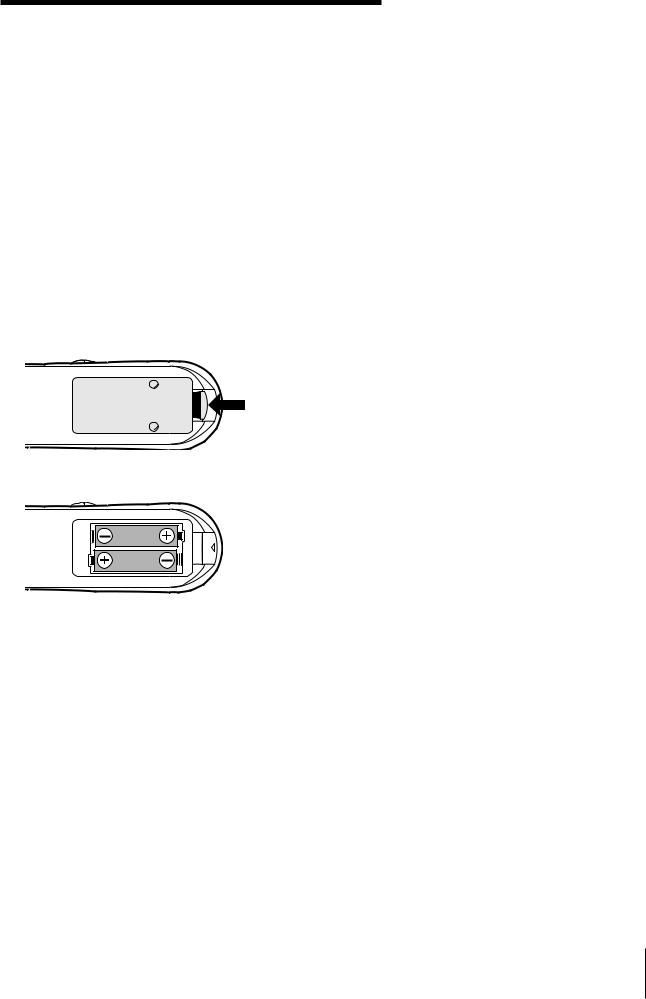
Using the remote control
Preparing the remote control for use
Your TV remote control can operate your TV and many brands of cable boxes, satellite receivers, VCRs, DVD players, and HTIBs (home theater in a box), even if they are different brands.
If you have a Toshiba device:
Your TV remote control is preprogrammed to operate most Toshiba devices. See page 18.
If you have a non-Toshiba device or a Toshiba device that the remote control is not preprogrammed to operate:
You can program the TV remote control so it will operate the other device. See pages 16–18.
Installing the remote control batteries
1. Remove the battery cover from the back of the remote control.
Squeeze tab and lift cover.
2.Install two “AA” size batteries, making sure to match the + and – signs on the batteries to the signs on the battery compartment.
3.Reinsert the battery cover in the remote control until the tab snaps.
Caution:
•Dispose of batteries in a designated disposal area. Do not throw batteries into a fire.
•Do not mix battery types or combine used batteries with new ones.
•If the remote control does not operate correctly, or if the operating range becomes reduced, replace both batteries with new ones.
•If the batteries are dead or if you will not use the remote control for a long time, remove the batteries to prevent battery acid from leaking into the battery compartment.
Note:
If your Toshiba TV remote control does not operate all the features of your other device, use the original remote control for that device.
Introduction |
|
|
|
|
|
Connecting |
yourTV |
|
|
|
|
Usingthe |
RemoteControl |
|
|
|
|
Settingup |
yourTV |
|
|
|
|
UsingtheTV’s |
Features |
|
|
|
|
Appendix |
|
|
|
|
|
Index |
|
|
|
15
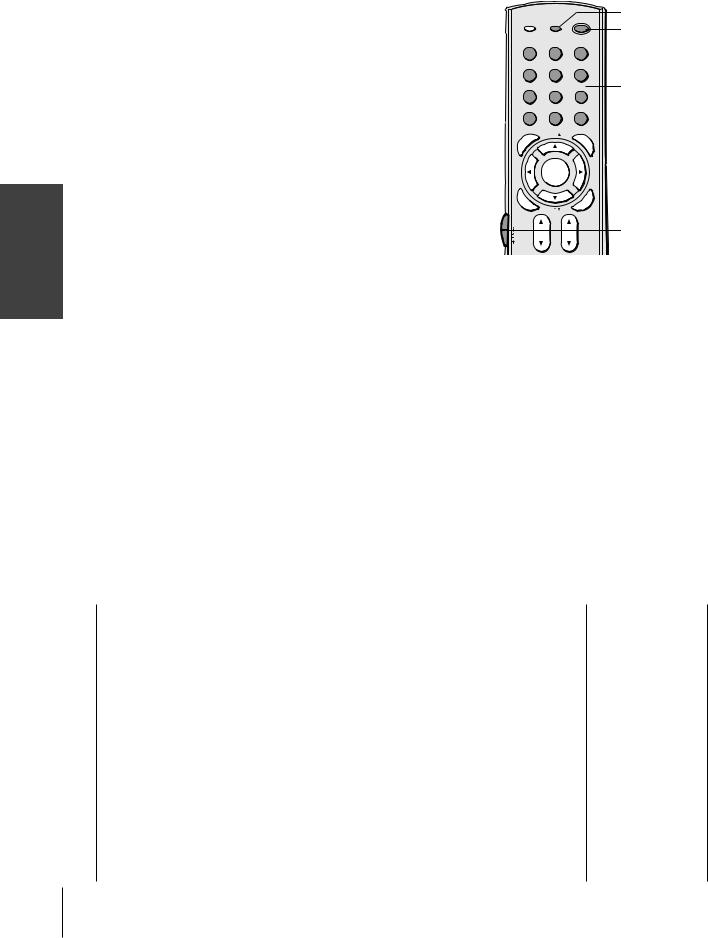
Remote Control
Using the
Programming the remote control
Your Toshiba TV remote control is preprogrammed to operate most Toshiba devices. To program your TV remote control to operate a non-Toshiba device or a Toshiba device that the remote control is not preprogrammed to operate, follow the steps below. For details on using the remote control to operate the device, see page 18.
1.In the remote control code table (below and on the next page), find the code for your device. If more than one code is listed, try each one separately until you find one that works.
2.Set the Device Switch to the type of device you are programming the remote control to operate — CBL/SAT (for a cable converter box or satellite receiver), VCR (for a VCR or TV/VCR combo), or DVD (for a DVD player or HTIB [home theater in a box]).
3.While holding down RECALL, press the Channel Number buttons to enter the 3-digit code for your device.
4.To test the code, turn on the device, point the remote control at it, and press POWER.
•If the correct code was entered, the device will turn off.
•If the device does not respond, repeat steps 1 – 4 using another code.
•If the device does not respond to another code, you will need to use the remote control that came with the device.
Note: In addition to POWER, confirm that all necessary keys on the TV remote control operate your device. If some keys are not operational, repeat the device code setup using another code (if other codes are listed for your device). If, after trying all listed codes, the necessary keys do not operate your device, use the device’s original remote control.
5.Remember to set the Device Switch back to TV to control the TV.
6.For future reference, write down the code(s) you used:
DEVICE |
CODE |
DEVICE |
CODE |
|
|
|
|
|
|
|
|
|
|
|
|
|
|
|
POWER |
|
|
RECALL |
||
|
|
|
TV/VIDEO RECALL |
|
|
POWER |
||||||
|
|
|
|
|
|
|
|
|||||
|
|
|
|
|
INFO |
|
|
|
|
|
||
|
|
|
|
|
|
|
|
|
|
|
||
|
|
|
|
1 |
2 |
|
|
3 |
|
|
|
|
|
|
|
|
4 |
5 |
|
|
6 |
|
|
|
Channel |
|
|
|
|
|
8 |
|
|
9 |
|
|
|
|
|
|
|
|
7 |
|
|
|
|
|
Number |
||
|
|
|
|
+10 |
|
CHRTN |
|
|
|
|||
|
|
|
100 |
0 |
|
|
ENT |
|
|
|
||
|
|
|
N |
|
|
|
G |
|
|
|
||
|
|
|
E |
U |
FAV |
|
|
|
UI |
|
|
|
|
|
P |
M |
|
|
|
PIC |
D |
|
|
||
|
O |
FAVORITE |
|
|
|
|
E |
|
||||
T |
|
|
|
|
|
|
SIZE |
|
|
|||
|
|
|
|
|
|
|
|
|
||||
|
|
|
|
|
|
|
|
|
|
|||
|
|
|
|
|
MENU |
|
|
|
|
|
|
|
|
|
|
|
|
DVDMENU |
|
|
|
|
|
||
NENTER |
|
|
|
EXIT |
|
R |
|
|||||
|
|
T |
|
|
|
|
|
|
|
|
||
E |
|
|
|
|
|
|
|
EA |
|
|
||
|
|
E |
|
FAV |
|
|
|
|
|
|
||
|
|
|
R |
|
|
|
|
|
L |
|
|
|
|
|
|
|
|
|
|
|
C |
|
|
Device Switch |
|
|
CBL/SAT |
CH |
|
VOL |
|
|
|
|
||||
|
TV |
|
|
|
|
|
|
|
|
|
||
|
VCR |
|
|
|
|
|
|
|
|
|
||
|
DVD |
|
|
|
|
|
|
|
|
|
||
|
|
|
|
POP DIRECT CH MUTE |
SLEEP |
|
|
|||||
TV/VCR |
PAUSE |
STOP |
PLAY |
|
|
|||||||
Note: |
|
FREEZE SOURCE |
SPLIT |
|
|
|||||||
|
|
REW |
FF |
SKIP/SEARCH |
|
|
||||||
CH SCAN |
SWAP |
|
POP CH |
|
|
|
|
|||||
• Every time you change the batteries, you |
||||||||||||
|
|
REC |
|
|
|
LIGHT |
|
|
||||
will need to reprogram the remote control.
•Some newer VCRs respond to either of two codes. These VCRs have a switch labeled “VCR1/VCR2.” If your VCR has this kind of switch and does not respond to the codes for your VCR brand, set the switch to the other position (“VCR1” or “VCR2”) and
reprogram the remote control.
Remote control codes
In some cases you may not be able to operate your device with the TV remote control. Your other device may use a code that is not recognized by the TV remote control. If this happens, you will need to use the remote control provided with the device.
Cable box |
|
Hitachi: 062, 095, 096 |
Realistic: 065 |
|
U. S. Electronics: 087, |
ABC: 061, 062, 063, |
|
Jasco: 097 |
Recoton: 102 |
|
096, 098 |
|
Jerrold: 062, 069, 071, |
Samsung: 077, 090 |
|
United Cable: 082 |
|
082, 084, 087, 091, |
|
|
|||
|
082, 086, 089, 091, |
Scientific Atlanta: 063, |
|
Universal: 065, 092, 097, |
|
092, 096, 098 |
|
|
|||
|
096 |
078, 079, 080, 088, |
|
099, 102, 103 |
|
Archer: 065, 092, 097, |
|
|
|||
|
Magnavox: 072, 096 |
098, 101, 105 |
|
Wards: 096 |
|
099 |
|
|
|||
|
Memorex: 091, 092, 104 |
Sears: 095 |
|
|
|
Cableview: 064, 094 |
|
|
|
||
|
Multi Canal: 090 |
Signature: 062 |
|
Satellite receiver |
|
Century: 092 |
|
|
|||
|
Novavision: 101 |
Signature 2000: 096 |
|
Alphastar: 038, 059 |
|
Citizen: 090, 092, 097 |
|
|
|||
|
Panasonic: 081, 083, 085 |
Sprucer: 081, 085 |
|
||
|
|
Chaparral: 034 |
|||
Contec: 083, 085, 086, |
|
|
|||
|
Philco: 087 |
Starcom: 069, 082, 087, |
|
||
|
|
DISH Network: 057 |
|||
088, 093, 098 |
|
|
|||
|
Philips: 066, 067, 068, |
096, 103, 104 |
|
||
|
|
Drake: 020, 040, 044, |
|||
Diamond: 093 |
|
|
|||
|
070, 072, 073, 074, |
Stargate: 069, 090 |
|
||
|
|
046, 050, 053 |
|||
Eagle: 091 |
|
|
|||
|
075, 091, 092 |
Sylvania: 095, 100 |
|
||
|
|
Echostar: 018, 041, 051 |
|||
GE: 061, 062 |
|
|
|||
|
Pioneer: 076, 077 |
TeleView: 090 |
|
||
|
|
Express Vu: 057 |
|||
Gemini: 069, 070, 094 |
|
|
|||
|
Proscan: 061, 062 |
Texscan: 100 |
|
||
|
|
Fujitsu: 027 |
|||
General Instruments: |
|
|
|||
|
Radio Shack: 092, 097, |
Tocom: 071, 084, 085 |
|
||
|
|
GE: 008, 009, 013 |
|||
062, 089, 096 |
|
|
|||
|
099 |
|
|
||
|
|
|
|
||
Hamlin: 093 |
|
|
|
|
|
|
RCA: 064, 081 |
|
|
|
|
|
|
|
|
|
General Instruments:
010, 011, 012, 022,
023, 031, 049
Hitachi: 033
Hughes: 033
Hughes Network
Systems: 019
Intersat: 048
Janeil: 027
JVC: 017, 057
Kenwood: 029
Magnavox: 060
Optimus: 058
Pansat: 036, 052
Primestar: 015, 042
Proscan: 008, 009, 013
Radio Shack: 022, 023,
030
16

Remote control codes (cont.)
Satellite receiver (cont.)
RCA: 008, 009, 013, 016
Realistic: 030
Samsung: 059
Sony: 014, 055
Star Choice: 057
Star Trak: 025, 026, 037,
054
STS: 024
Toshiba: 000, 001, 002,
003, 004, 005, 006,
007, 020, 031, 056
Uniden: 021, 028, 030,
032, 035, 039, 043,
045, 047, 058
Zenith: 027
TV/VCR Combo
Action: 078
GE: 059, 062
Goldstar: 065
Panasonic: 065
Precision: 078
Quasar: 065
Realistic: 079
Sony: 074
Toshiba: 057
Zenith: 065
DVD/VCR Combo
Go Video:
DVD=087, VCR=081 JVC:
DVD=088, VCR=082 RCA:
DVD=089, VCR=083 Samsung:
DVD=090, VCR=084 Sanyo:
DVD=091, VCR=085 Zenith:
DVD=092, VCR=086
DVD player
Aiwa: 006, 015
Apex: 016, 017
BOSE: 097
Broksonic: 018
Clarion: 019
Classic: 020
Daewoo: 021
Denon: 022, 023, 024,
025
Emerson: 026, 027
Fisher: 028
Funai: 027
GE: 001, 029, 030
Go Video: 087
GPX: 031
Hitachi: 005, 032, 033,
034, 035
JVC: 003, 007, 036,
042, 088
Kenwood: 037
Konka: 008, 009
Magnavox: 004, 038
Memorex: 039
Mintek: 040
NAD: 026
Nakamichi: 041
Norcent: 043
Onkyo: 044
Oritron: 058
Panasonic: 010, 045,
046, 047, 048, 049,
050
Philips: 004, 051
Pioneer: 052, 053, 054,
055
Proscan: 001, 056
Qwestar: 057, 058
RCA: 001, 002, 059, 089
Sampo: 060
Samsung: 061, 062, 086,
090
Sansui: 073
Sanyo: 063, 091
Sharp: 064, 067
Sherwood: 074
Sony: 011, 012, 065,
066, 068, 069, 070
Sylvania: 027
Teac: 071
Technics: 072
Techwood: 075
Toshiba: 000, 013, 076,
077, 078
Yamaha: 079, 080, 081
Zenith: 014, 082, 092
Portable DVD player
Aiwa: 093
Audiovox: 094, 095
Panasonic: 024, 096, 099
RCA: 098
VCR
Admiral: 049
Aiko: 019
Aiwa: 018
Akai: 003, 004, 037,
038, 039, 058, 069
Audiovox: 010
Bell & Howell: 007, 068
Broksonic: 008, 017
Calix: 010
Carver: 026
CCE: 019
Citizen: 009, 010, 011,
012, 013, 014, 015,
019, 057, 073
Colortyme: 005 |
Memorex: 007, 009, |
|
Sanyo: 007, 009, 016, |
Craig: 009, 010, 016, |
010, 016, 018, 034, |
054, 064, 068, 071, |
|
061, 065, 079 |
049, 063, 065, 066, |
075, 079, 085 |
|
Curtis Mathes: 001, 005, |
068, 075, 079 |
|
Scott: 008, 011, 017, |
009, 012, 014, 040, |
MGA: 020, 028, 039 |
028, 030, 057, 065, |
|
048, 053, 056, 057 |
MGN: 056 |
072 |
|
Daewoo: 011, 013, 015, |
Minolta: 024, 025, 035, |
|
Sears: 007, 010, 016, |
017, 018, 019, 057, |
063 |
021, 022, 023, 024, |
|
078 |
Mitsubishi: 020, 024, |
025, 035, 053, 057, |
|
Daytron: 078 |
025, 028, 039, 043, |
063, 064, 065, 068, |
|
Denon: 063 |
065 |
071, 075, 079 |
|
Dimensia: 001, 048 |
Montgomery Ward: 049 |
|
Sharp: 013, 020, 031, |
Electrohome: 010, 020, |
Motorola: 049 |
049, 051, 060, 066 |
|
065 |
MTC: 009, 046, 061 |
|
Shintom: 004, 025, 032, |
Emerson: 003, 008, 010, |
Multitech: 009, 012, 018 |
061 |
|
011, 017, 018, 020, |
NEC: 005, 006, 007, |
|
Signature: 049 |
028, 039, 054, 057, |
012, 014, 037, 043, |
|
Signature 2000: 075 |
062, 065, 068, 072 |
053, 054, 067, 070 |
|
Singer: 047, 061 |
Fisher: 007, 016, 021, |
Nikko: 010 |
|
Sony: 004, 032, 033, |
022, 023, 057, 064, |
Noblex: 009 |
041, 052, 058, 070, |
|
068, 070, 071, 079 |
Optimus: 010, 049, 065 |
074, 076, 077, 080 |
|
Fuji: 004, 041 |
Optonica: 031 |
|
STS: 035 |
Funai: 018, 073 |
Orion: 054, 057, 062, |
|
Sylvania: 018, 026, 027, |
Garrard: 018 |
065, 068, 072 |
028, 044, 072 |
|
GE: 001, 002, 009, 040, |
Panasonic: 036, 045, |
|
Symphonic: 018, 050, |
042, 048, 056 |
046, 057, 061, 072, |
051, 053, 073, 079 |
|
Go Video: 056, 059, |
079 |
|
Tandy: 007 |
061, 081 |
Pentax: 012, 024, 025, |
|
Tashiko: 010 |
Goldstar: 005, 010, 014, |
035, 042, 053, 063 |
|
Tatung: 037 |
054, 056, 065, 067 |
Pentex Research: 014 |
|
Teac: 018, 029, 037 |
Gradiente: 018, 065 |
Philco: 026, 027, 063 |
|
Technics: 036 |
Harman Kardon: 005 |
Philips: 026, 031, 044, |
|
Teknika: 010, 018, 065 |
Hitachi: 024, 025, 035, |
057 |
|
Toshiba: 000, 011, 021, |
037, 042, 063, 070, |
Pioneer: 006, 024, 043, |
023, 024, 028, 030, |
|
080 |
055 |
039, 057, 074, 078, |
|
JBL: 076 |
Portland: 012, 013, 015 |
079 |
|
JC Penney: 005, 006, |
Proscan: 001, 002, 048 |
|
Totevision: 009, 010, |
007, 008, 009, 010, |
Proton: 061 |
065 |
|
023, 024, 025, 026, |
Quasar: 045 |
|
Unitec: 073 |
035, 056, 061, 063, |
Radio Shack: 010, 031, |
|
Unitech: 009 |
065 |
065 |
|
Vector Research: 005, |
Jensen: 024, 025, 037, |
Radio Shack/Realistic: |
006, 011, 012, 053 |
|
050 |
007, 009, 010, 016, |
|
Video Concepts: 005, |
JVC: 005, 006, 007, |
018, 020, 021, 022, |
006, 011, 012, 039, |
|
014, 037, 043, 050, |
031, 049 |
053 |
|
062, 063, 068, 082 |
Radix: 010 |
|
Wards: 009, 010, 011, |
Kenwood: 005, 006, |
RCA: 001, 002, 003, |
016, 018, 020, 024, |
|
007, 012, 014, 037, |
009, 024, 025, 029, |
025, 031, 035, 049, |
|
043, 050, 053, 068, |
035, 040, 042, 045, |
051, 056, 057, 060, |
|
071 |
048, 055, 056, 063, |
065, 066, 079 |
|
Kodak: 010 |
071, 083 |
|
White Westinghouse: |
LG: 010 |
Realistic: 007, 009, 010, |
073 |
|
Lloyds: 053, 073, 079 |
011, 016, 018, 020, |
|
XR-1000: 018 |
Logik: 061 |
021, 022, 031, 049, |
|
Yamaha: 005, 006, 007, |
LXI: 010 |
051, 056, 060, 065, |
014, 037, 053 |
|
Magnasonic: 061, 065, |
075, 079 |
|
Zenith: 004, 032, 034, |
078 |
Ricoh: 047 |
041, 047, 069, 086 |
|
Magnavox: 026, 027, |
Runco: 034 |
|
|
034, 044, 057, 061, |
Samsung: 009, 011, 038, |
|
HTIB |
072 |
056, 073, 084 |
|
Lasonic: 083 |
Marantz: 005, 006, 007, |
Sansui: 006, 037, 043, |
|
|
|
Panasonic: 084 |
||
012, 014, 026, 053, |
061 |
|
|
|
Venturer: 085 |
||
067 |
|
|
|
|
|
|
|
Introduction |
|
|
|
|
|
Connecting |
yourTV |
|
|
|
|
Usingthe |
RemoteControl |
|
|
|
|
Settingup |
yourTV |
|
|
|
|
UsingtheTV’s |
Features |
|
|
|
|
Appendix |
|
|
|
|
|
Index |
|
|
|
17
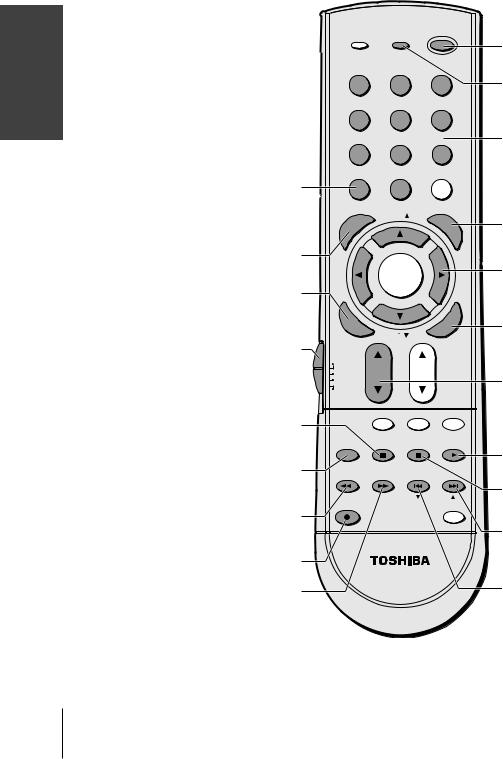
Remote Control
Using the
Using the remote control to operate your other devices
If you have a non-Toshiba device or a Toshiba device that the remote control is not preprogrammed to operate, you must first program the remote control to recognize the device (if you have not already done so). See pages 16 and 17.
To use your TV remote control to operate a:
•cable box or satellite receiver, set the Device Switch to CBL/SAT.
•VCR, set the Device Switch to VCR.
•DVD player or HTIB, set the Device Switch to DVD.
Point the remote control directly at the device.
Note:
Even after the TV remote control is programmed, it may not operate certain features on your other device. If this happens and you wish to use those features, you will need to use the device’s original remote control.
+10 (DVD only)
Press to directly access DVD chapters higher than 10.
TOP MENU (DVD only)
Accesses a DVD’s top menu.
ENTER
Required by some VCRs and cable converter boxes to change the channel.
Device Switch
Set to “TV” to control the TV; “CBL/SAT” to control a cable box or satellite receiver; “VCR” to control a VCR; “DVD” to control a DVD player or HTIB.
PAUSE
Press during play or record mode to pause the picture; press again to restart.
TV/VCR (VCR only)
To view one program while recording another, press to select TV mode.
REW
Rewinds the tape or DVD. (Press during play mode to view the picture moving rapidly backward.)
REC (VCR only)
Starts tape recording.
FF
Fast-forwards the tape or DVD. (Press during play mode to view the picture moving rapidly forward.)
TV / VIDEO RECALL |
POWER |
|
|
INFO |
|
1 2 3
4 5 6
|
|
7 |
8 |
9 |
|
|
|
|
|
|
+10 |
|
CHRTN |
|
|
||
|
|
100 |
0 |
ENT |
|
|
|
|
|
|
U |
|
|
G |
|
|
|
|
|
N |
|
|
|
|
|
|
|
|
E |
|
|
U |
|
|
|
|
|
M |
FAV |
|
|
I |
|
|
|
|
PI |
|
D |
|
|||
|
P |
FAVORITE |
|
|
|
E |
||
O |
|
|
C |
|
|
|
||
|
|
|
|
I |
|
|
|
|
T |
|
|
|
|
S |
|
|
|
|
|
|
|
ZE |
|
|||
|
|
|
MENU |
|
|
|
|
|
|
|
|
DVDMENU |
|
|
|
|
|
NENTER |
|
|
EXIT |
|
R |
|||
E |
E |
FAV |
|
|
|
EA |
|
|
|
T |
|
|
|
|
|
|
|
|
|
R |
|
|
|
L |
|
|
|
|
|
|
C |
|
|
||
|
TV |
|
|
|
|
|
|
|
|
CBL/SAT CH |
VOL |
|
|
|
|
||
|
VCR |
|
|
|
|
|
|
|
|
DVD |
|
|
|
|
|
|
|
|
|
POP DIRECT CH MUTE |
|
SLEEP |
|
|||
TV/VCR PAUSE STOP PLAY
|
FREEZE |
SOURCE |
SPLIT |
REW |
FF |
SKIP/SEARCH |
|
CH SCAN |
SWAP |
POP CH |
|
REC |
|
|
LIGHT |
CT-90159
POWER
Turns the selected device on and off.
INFO (CBL/SAT only)
Displays on-screen information.
Channel Numbers (0-9)
Press to directly access channels (as opposed to CH y z).
GUIDE (CBL/SAT only)
Displays channel guide.
y z x • (DVD only)
Press to navigate DVD menus
(may not work on some DVD players).
CLEAR (DVD only)
Press to reset the title and chapter number.
CH y z
y selects the next higher channel; z selects the next lower channel.
PLAY
Begins playback of a tape or DVD.
STOP
Stops the tape or DVD.
SKIP/SEARCH  (DVD only)
(DVD only)
Skips forward to later DVD chapters.
SKIP/SEARCH  (DVD only)
(DVD only)
Skips back to beginning of current DVD chapter or previous chapters.
18
